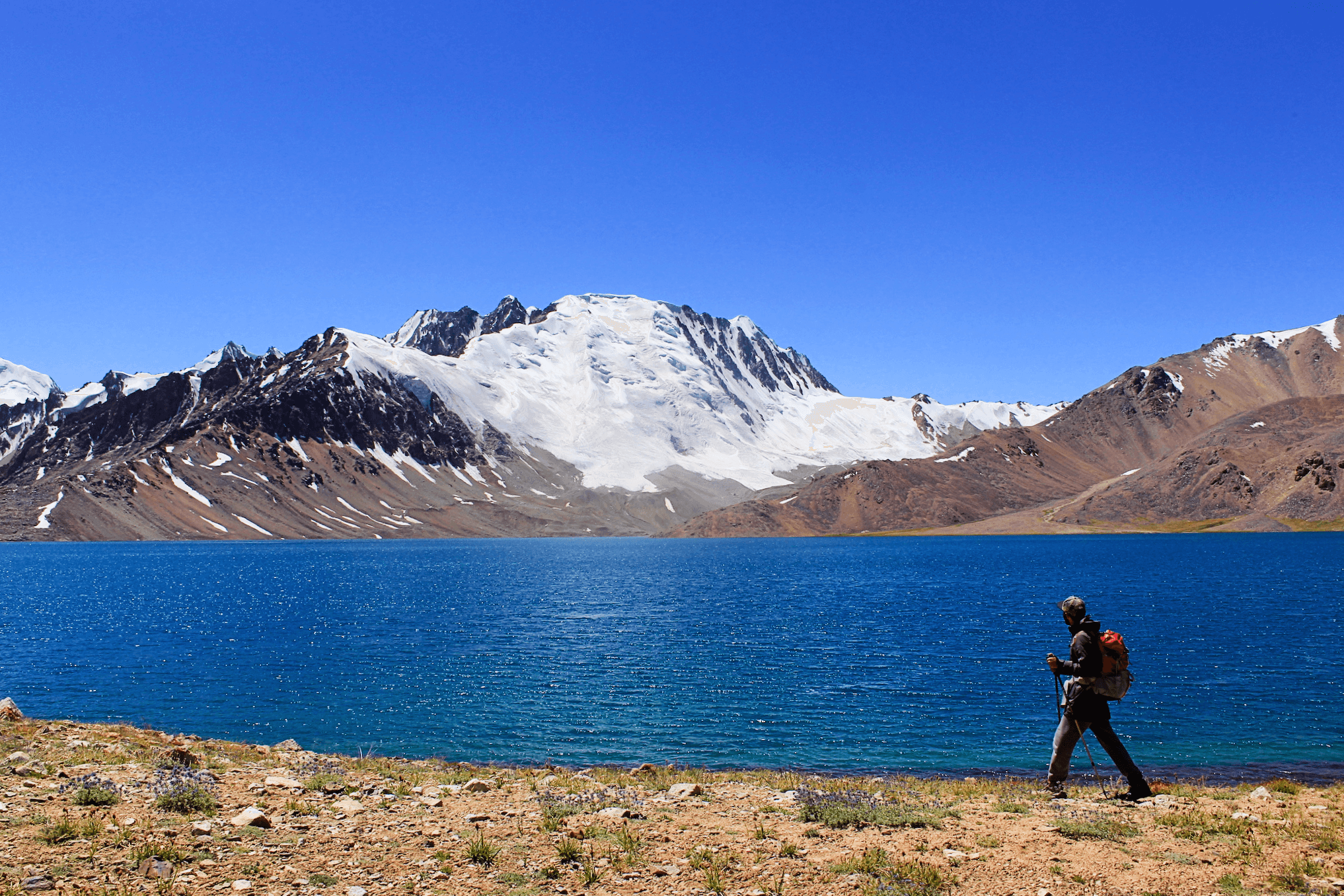
Trek the Pamir Mountains in Tajikistan
Get truly remote in Central Asia on a high-altitude hike through the 'Roof of the World'
What's Included?
Activities & Certified Guides
All itinerary activities with English-speaking tour leader plus a specialist local mountain guideAll accommodation
7 nights in guesthouses and hotels, 6 nights camping, 2 nights in a Tajik homestayMeals
All breakfasts, 12 lunches, 10 dinnersTransfers
Airport and local transfers, with donkeys and porters to transport your luggage during the trekEquipment & Permits
Expedition tents, sleeping mats, Tajik National Park entry permits, plus GBAO regional travel permitSmall Like-minded Groups
Solo-friendly by design, join our small n’ sociable groups of up to 14 like-minded, active and outdoorsy people…
…
What's it like?

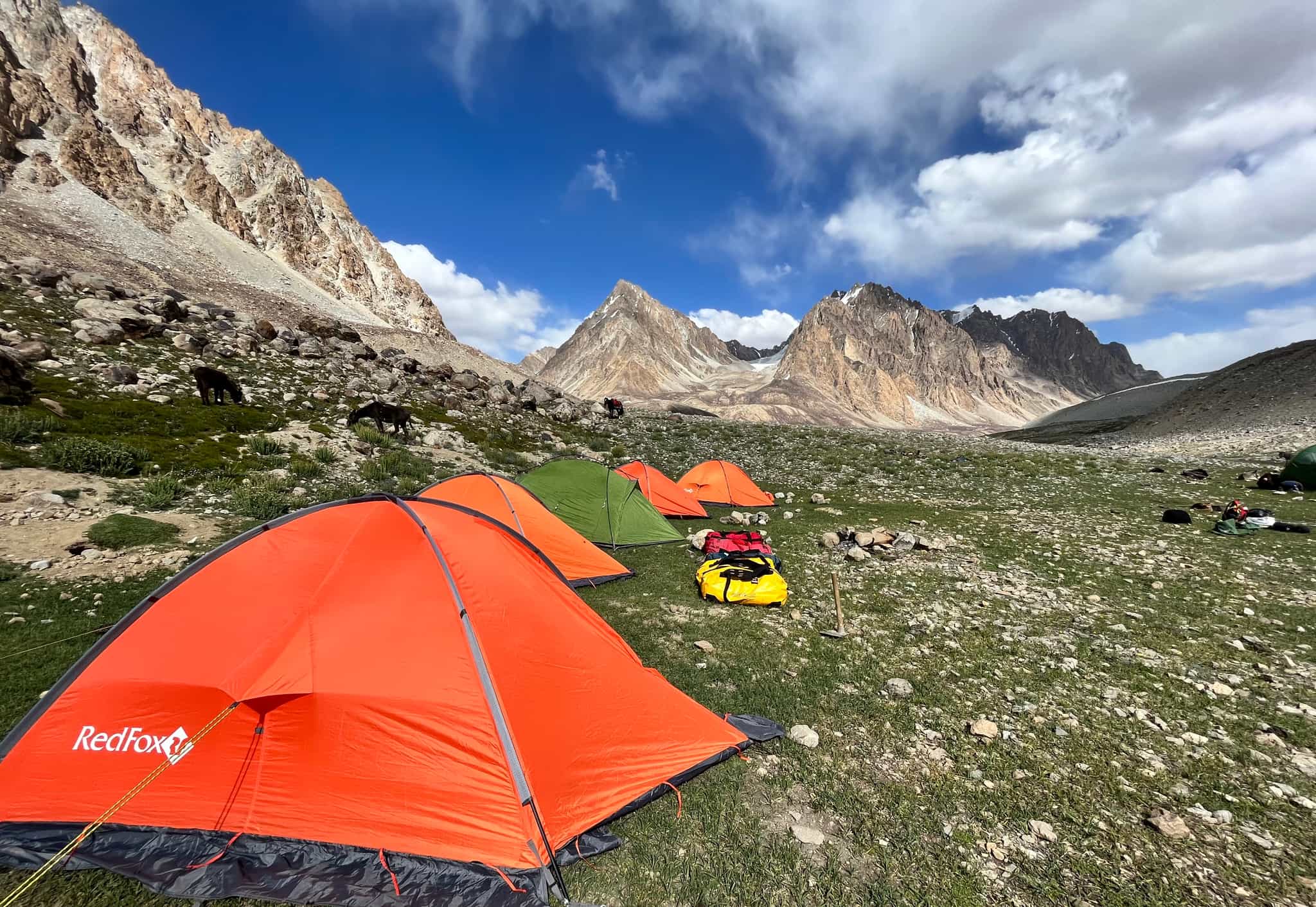
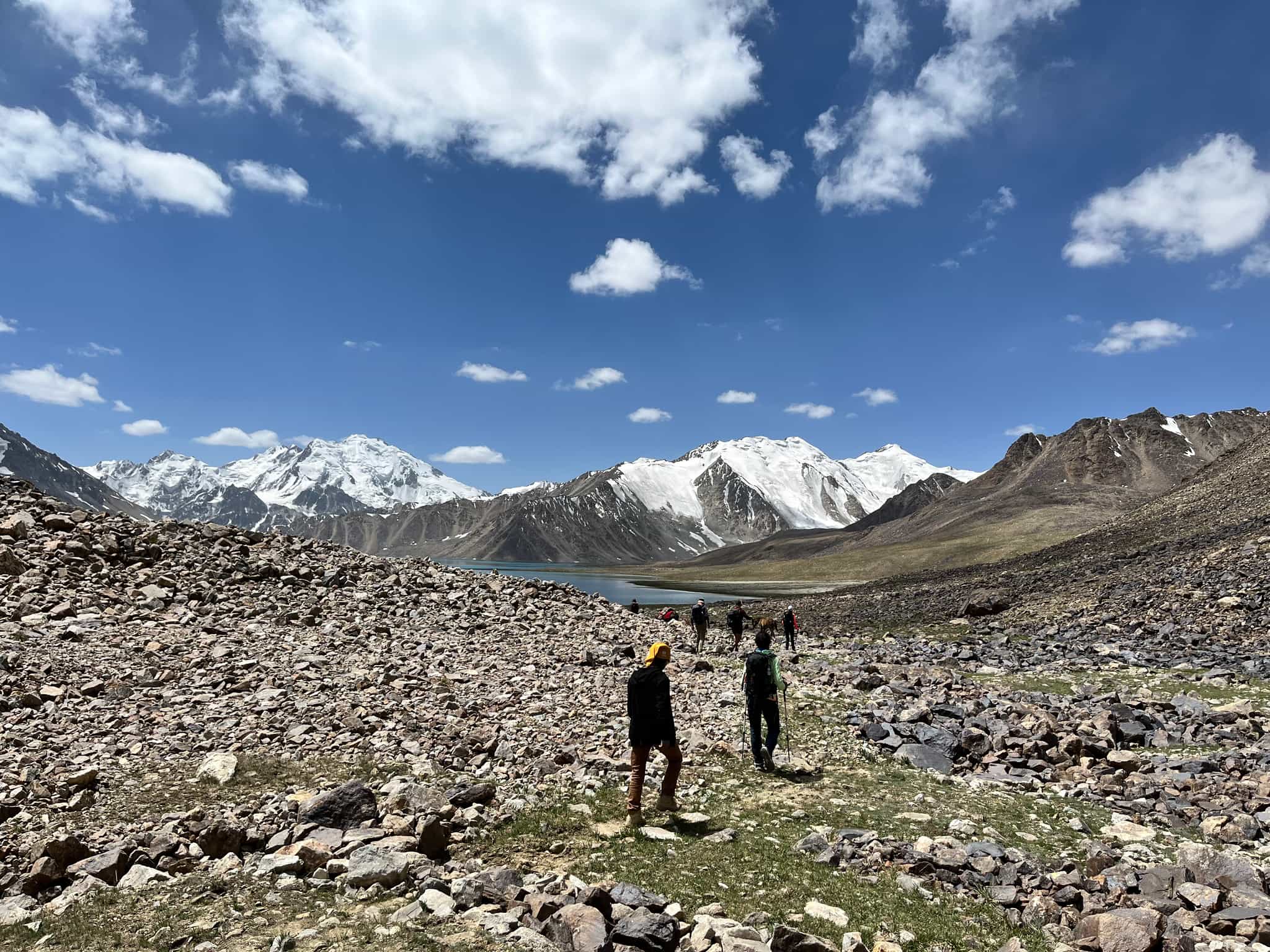
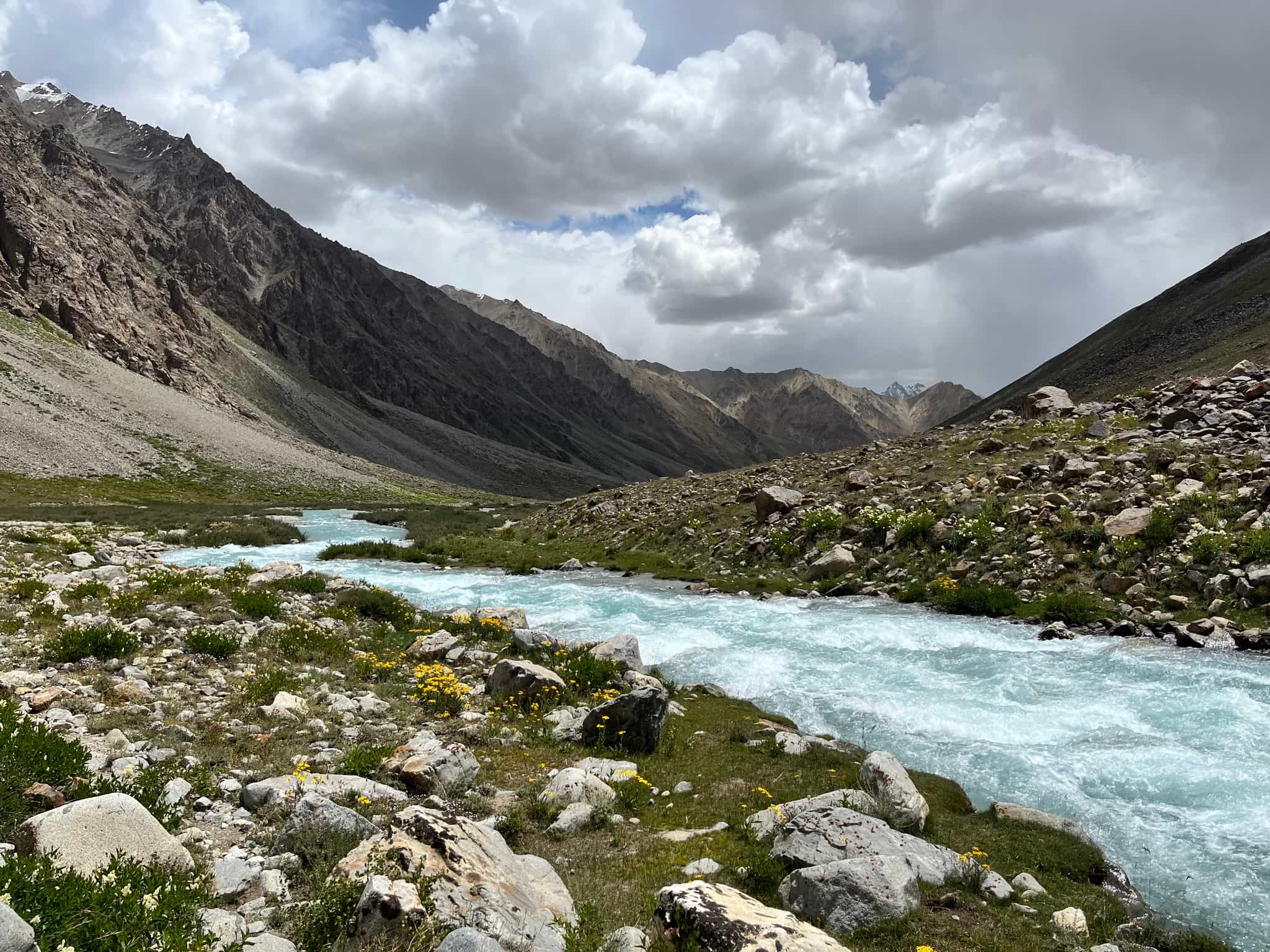

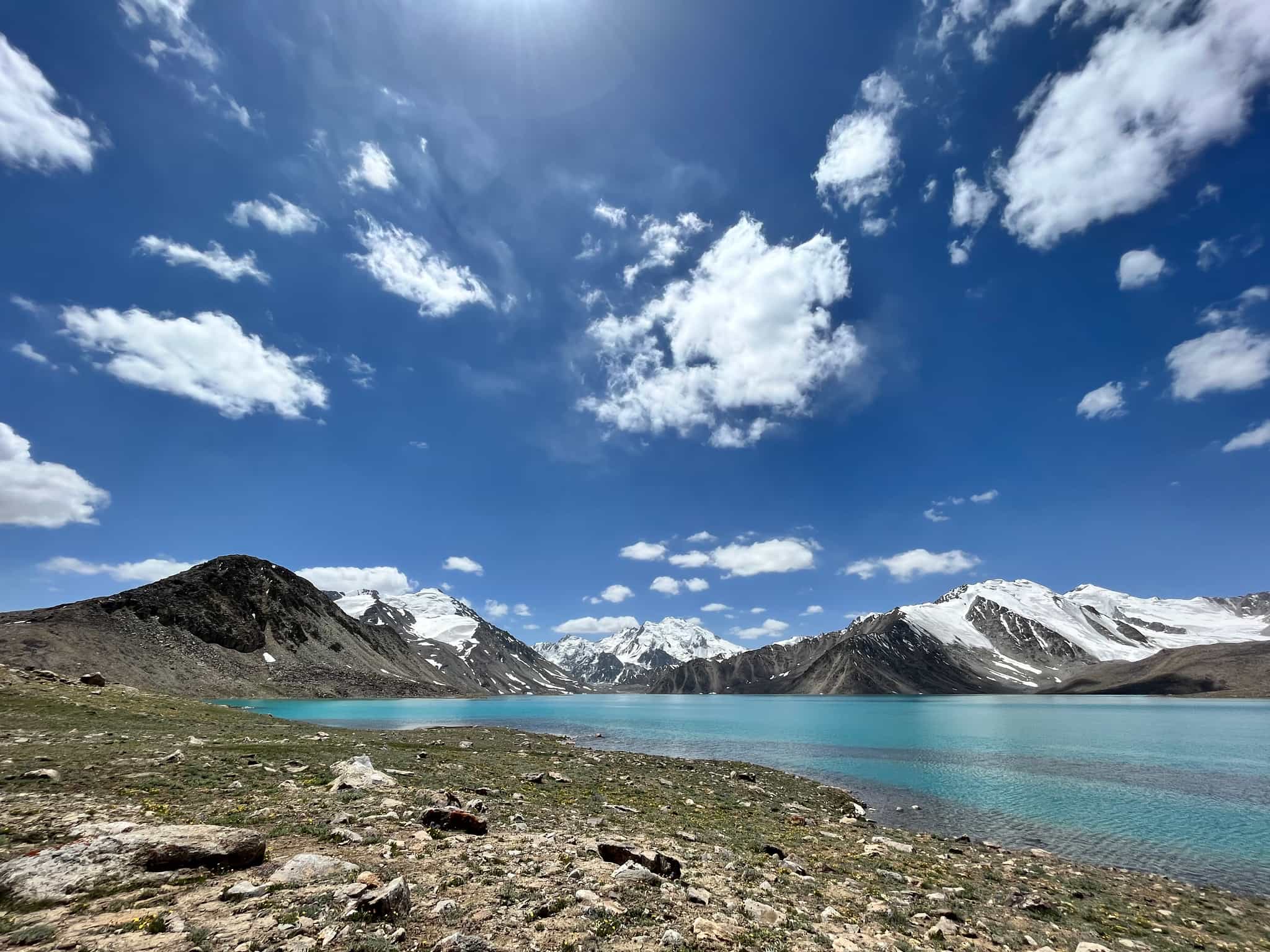
Trek spectacular sections of the Pamir Trail, a new long-distance hiking trail that weaves below towering 7000m peaks
Experience a warm Tajik welcome in villages and homestays, on an epic road trip from Dushanbe to the Pamirs
Camp beside azure alpine lakes and rivers in some of the most remote mountain scenery on the planet, and soak in the natural hot springs of Kavk
Key Information
Day 1
Welcome to Tajikistan
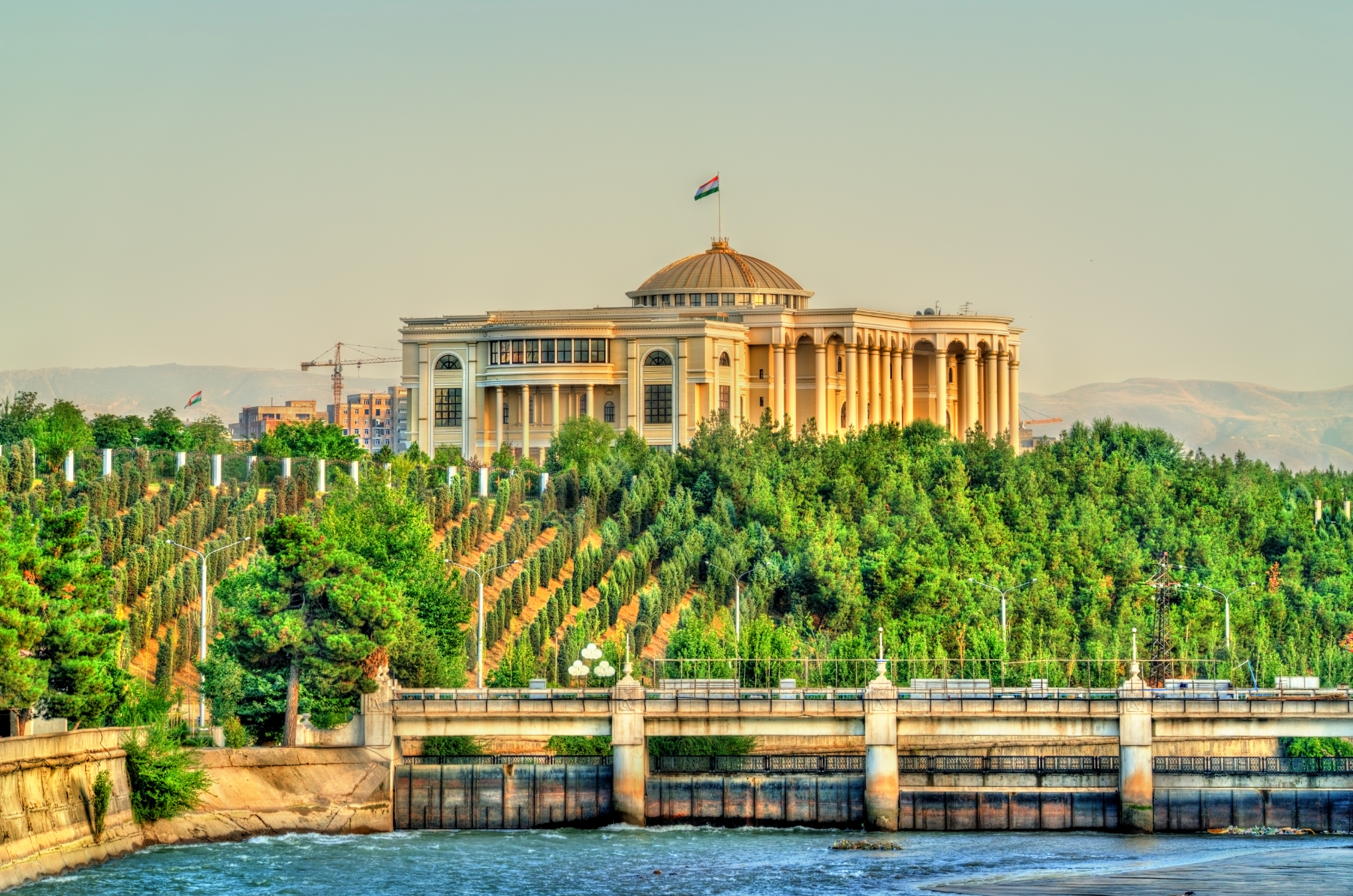
Due to flight schedules to Dushanbe, hotel accommodation is booked for this first night based on the majority of international travellers will be flying on Day 1 from Istanbul on Turkish Airlines flight TK254 and arriving in the very early hours of Day 2. A group arrival transfer is included to connect with this flight. Please read the Getting There section below for more details on the recommend flight options for this trip, which effectively starts at midday on Day 2 to allow time for everyone to arrive at the starting hotel and rest up from their long journey. Those choosing to arrive early into Dushanbe can ask the host to assist with additional nights of accommodation and private transfers.
Day 2
Touchdown in Dushanbe
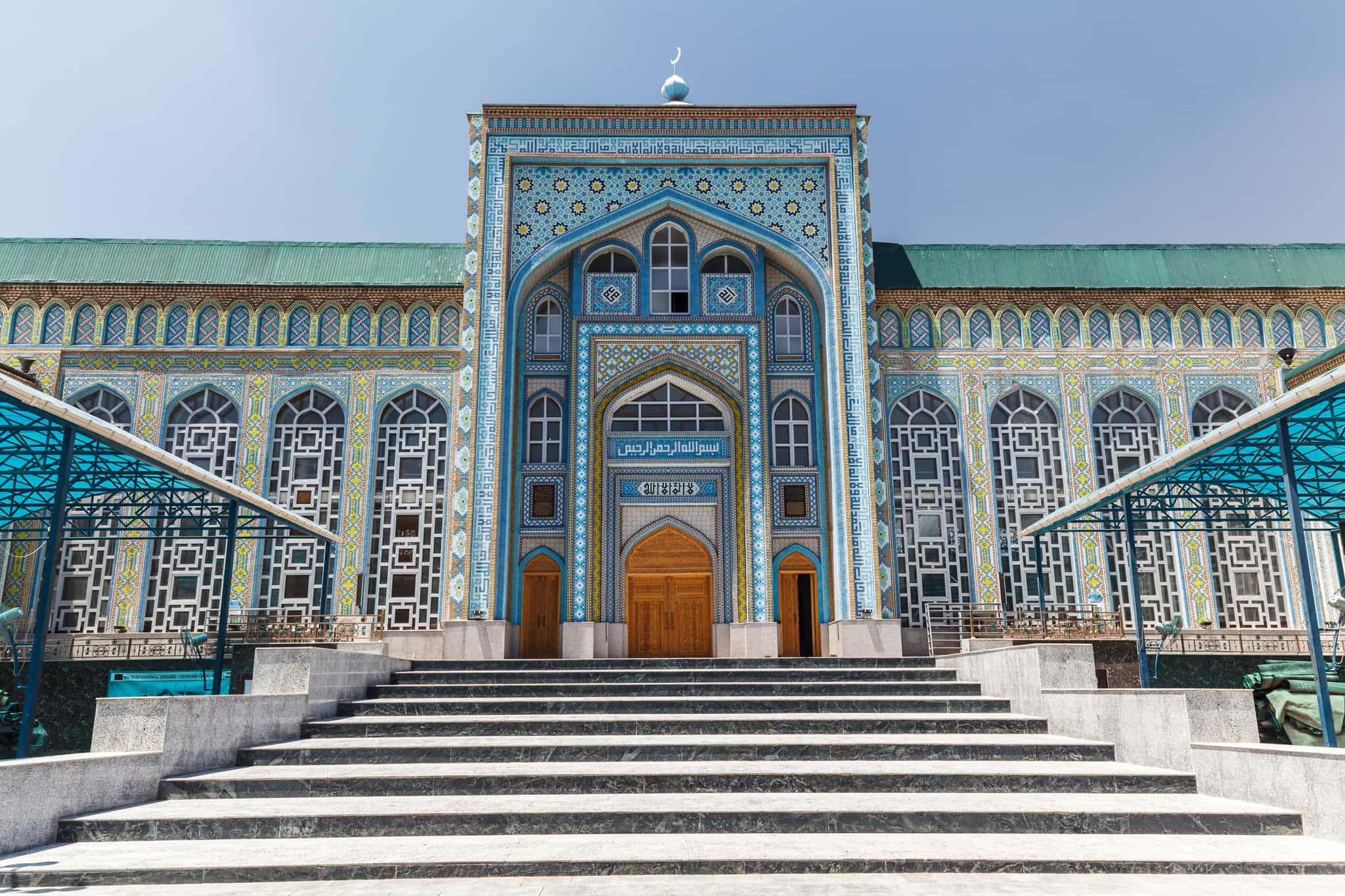
Welcome to Dushanbe! Your host will meet you at the airport in the early hours of this morning and transfer you to your hotel, where you can get some much needed rest after your long flight. Enjoy a late breakfast, then around midday meet up with your tour leader and fellow adventurers for a briefing on the expedition ahead. Head out to a local restaurant for some lunch before spending the afternoon exploring the monuments, museums and bazaars of Tajikistan's capital before dinner at a local restaurant.
Day 3
Hit the road to Kalai Khumb
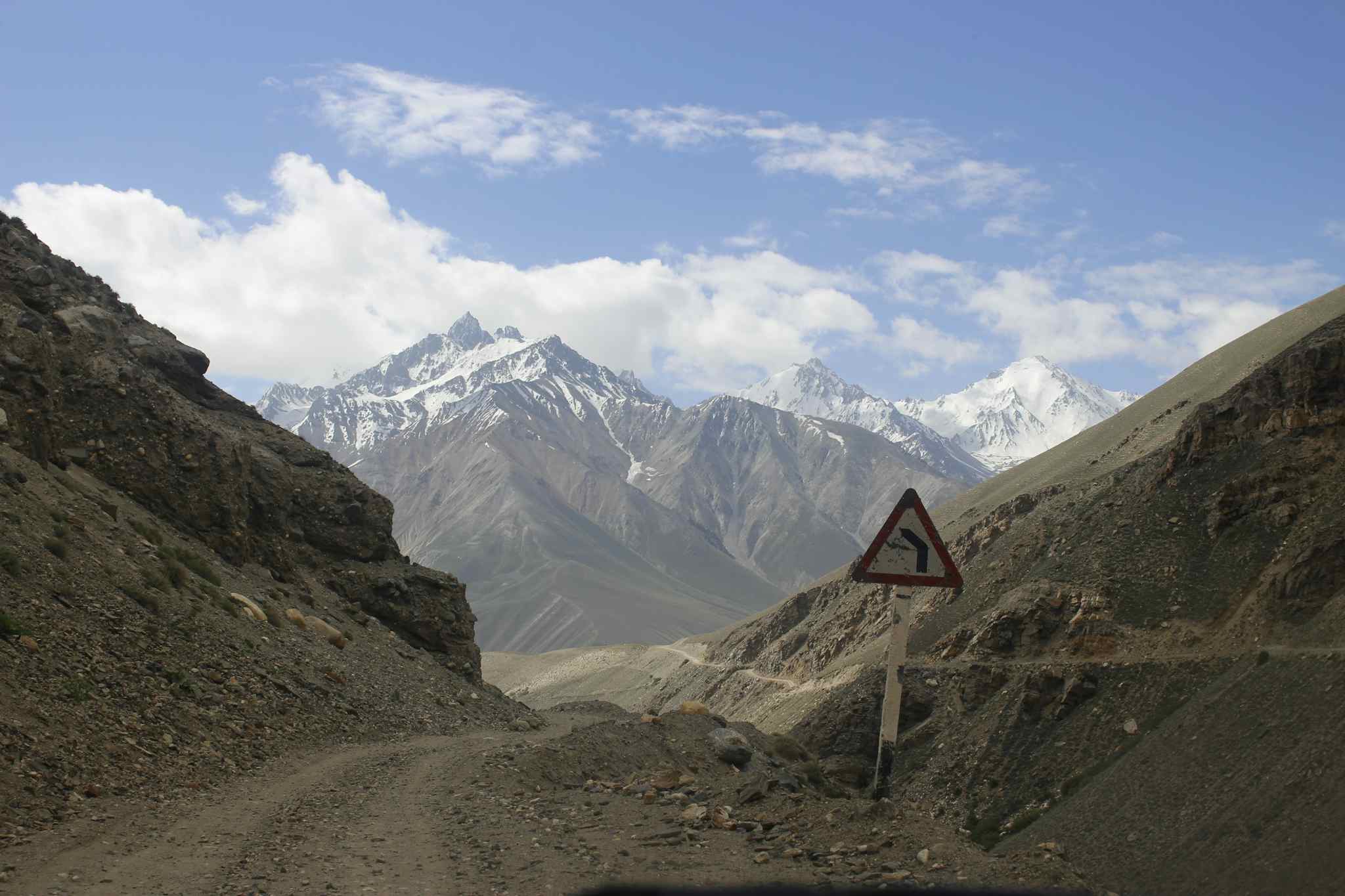
Driving
The expedition gets under way as you head off for a two-day road trip, heading east to reach the Pamir Mountains. Orchards and villages are embedded in the green landscape which lines the route from Dushanbe. Stop at Nurek Lake to stretch your legs while taking in the views of this vast reservoir with the second highest dam in the world. On the way to Kulob you'll pass through a narrow ravine and then cross a high pass, bordered by bizarrely weathered, red-brown conglomerate rocks. Enjoy a picnic lunch by the mighty Panj River. Reaching Kalai Khumb (1270m) in the late afternoon, get to know Pamir hospitality for the first time at your privately run guesthouse as you chat to your hosts over dinner.
Day 4
Along the Pamir Highway to Khorog
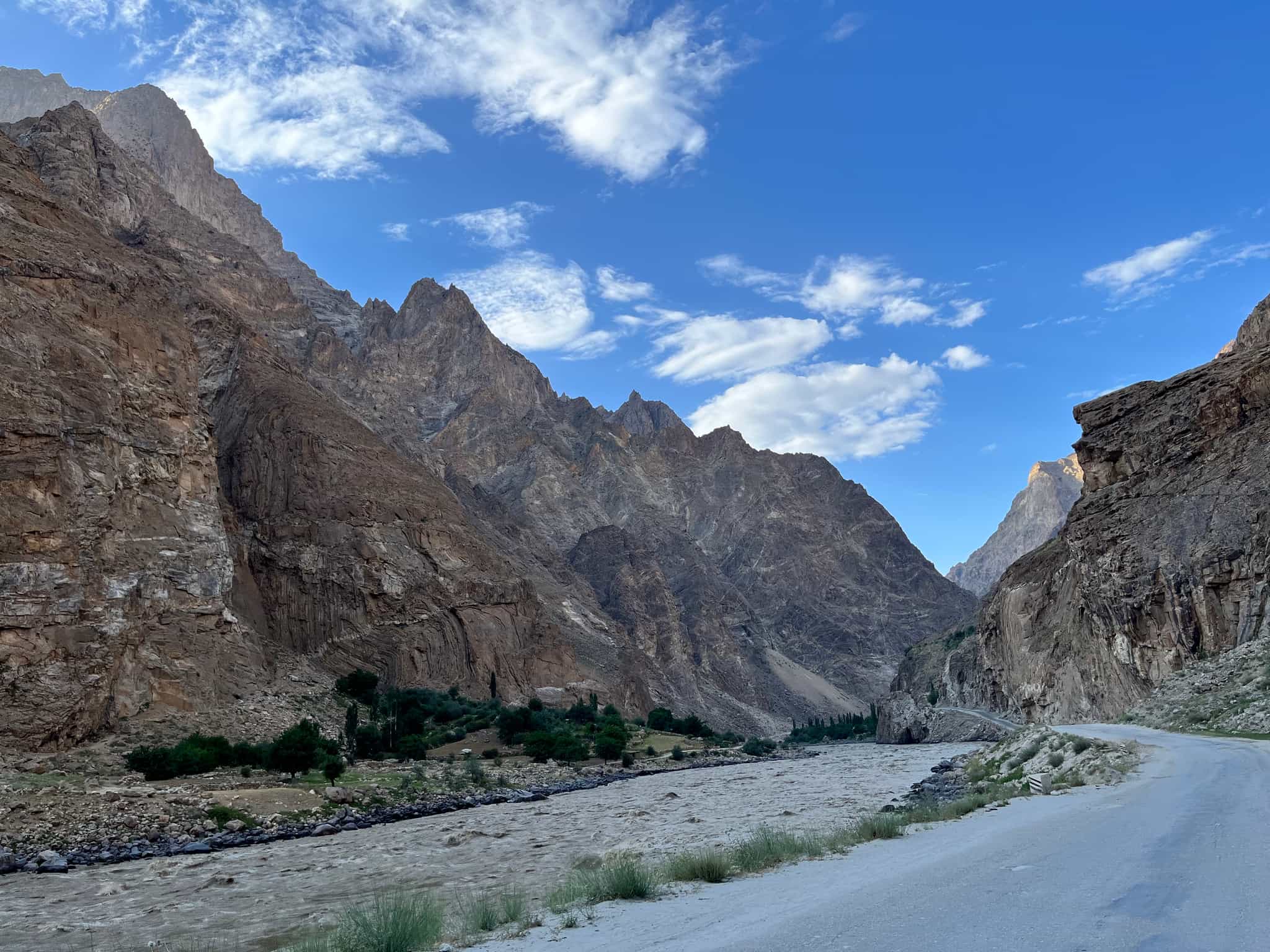
Driving
Hiking
Start the day with a hike up to the Karon archaeological site at 1700m, palace ruins dated to 2nd Century BC, providing spectacular views of the surrounding mountains. Today's drive follows the mighty Panj River, which forms the border with Afghanistan. The road squeezes into a huge ravine between the rugged mountain ranges of the West Pamirs, and there are plenty of stops along the route to stretch your legs and take in this unique place. By evening, you'll reach Khorog, the capital of the mountainous region of Badakhshan where you'll be staying in order to acclimatise before the trek. Khorog sits at 2070m on the Pamir Highway, in a narrow valley where the azure rivers Shakhdara and Ghund flow towards the murky Panj. The small town is also an important cultural centre with two universities, a public library, a theatre and the world's second-highest botanical garden (2300m).
Day 5
Khorog to Bulunkul
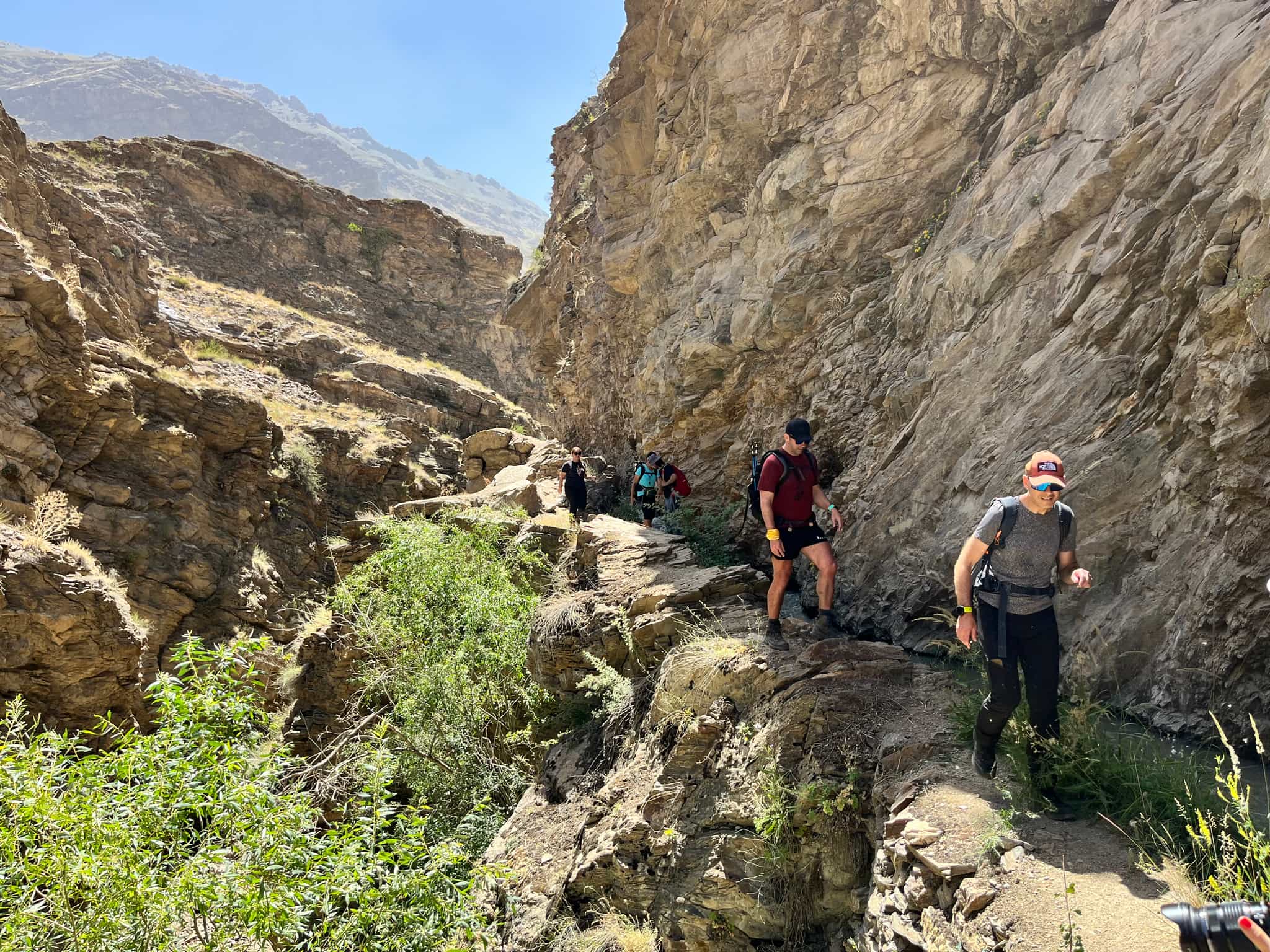
Hiking
Driving
Start the day with a short walking tour of Khorog town, then it's time for an acclimatisation hike up to the Botanical Gardens high above the city. The garden was created in 1940 and is a small oasis of over 2000 plant species, with fantastic views of Khorog and the Pamir Mountains in the distance. Then walk down to another hiking area popular with locals, perhaps there may be chance to stop for a cup of tea in one of the houses. After lunch you'll drive on from Khorog towards the Ghund Valley, along the way stopping for views of the silver-coloured salt lakes Sasyk and Tuzkul, before entering Bulunkul village (3700m), where the temperature drops to -63° C in winter (luckily, this is a summer trek!) Overnight at a local guesthouse.
Day 6
The trek begins
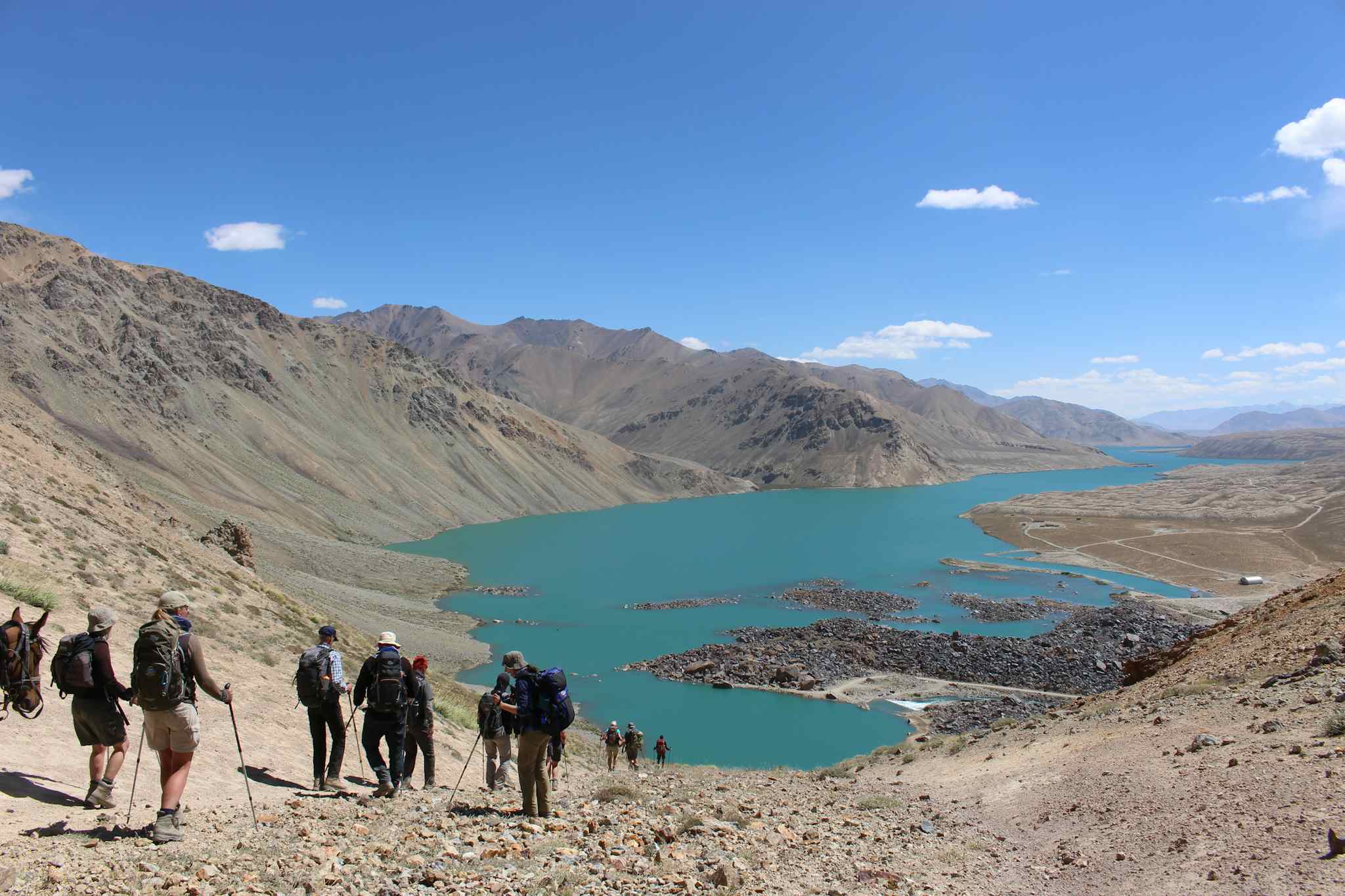
Trekking
Driving
Begin the day with an easy walk around Bulunkul village meeting the locals of this remote community, before setting off around the lake shore. Have lunch at a homestay by Yashilkul Lake and then a short drive to where you'll meet the rest of the trekking team, who will provide logistics support for your adventure. You'll then start the trek proper by hiking up over Burghumol Pass (3925m) to reach the Langar Dara Valley. Your first overnight camp will be here (at 3760m).
Day 7
Hiking beneath giants
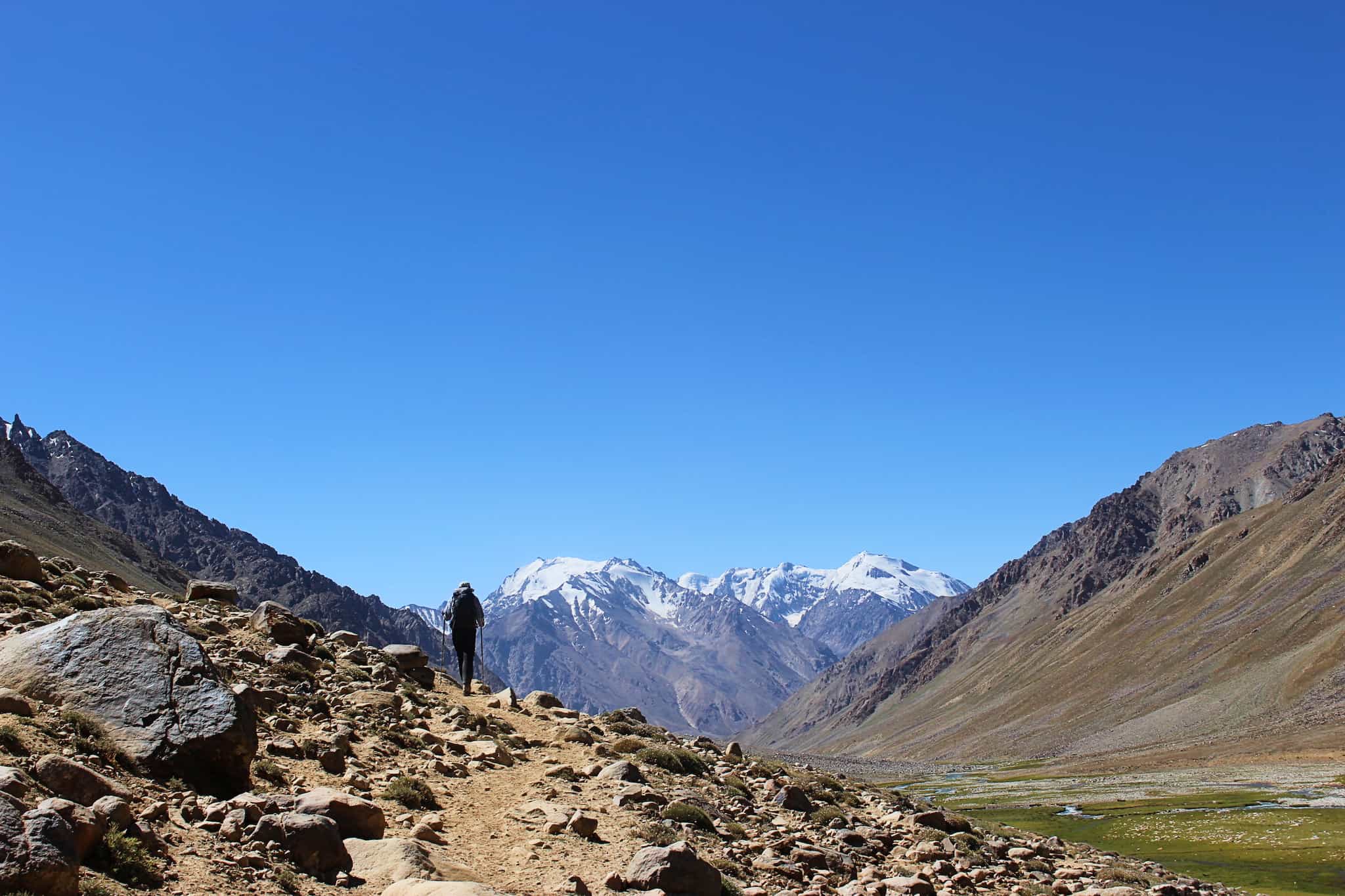
Trekking
Have breakfast at camp before lacing the boots back up, to hike the trail up through the Langar Dara Valley. The landscape here is spectacular, with 6000m peaks looming above. The trails climbs slowly but steadily towards the next camping spot. Along the trail, you might stop at a shepherd's summer house for a cup of tea. Reach camp and enjoy dinner and a spot of stargazing tonight as the twilight fades.
Day 8
Movin' on up
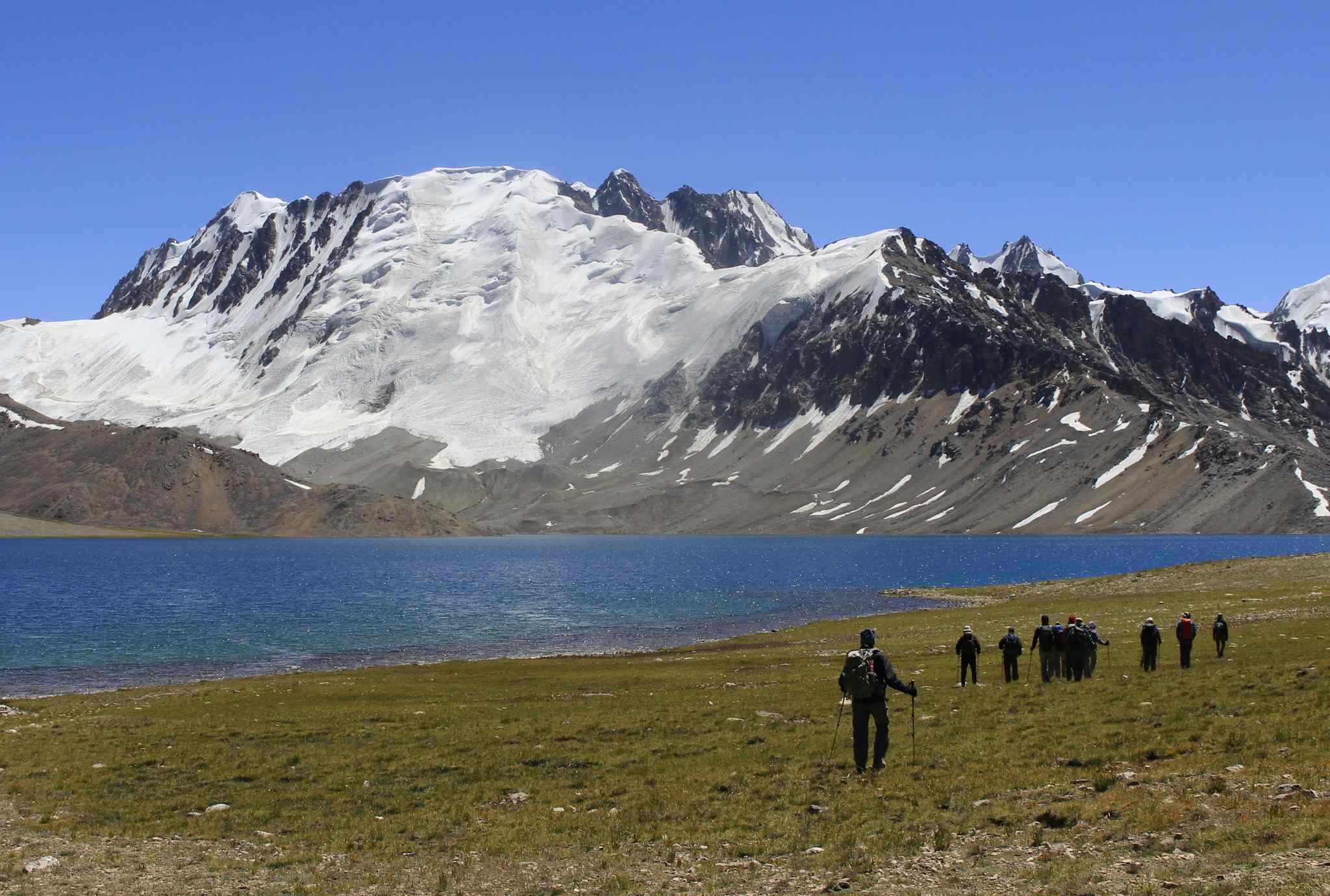
Trekking
Heading higher into the peaks there are two route options available today. The first is via the Langar Pass (4630m) which is a longer trek but easier-going for the donkeys carrying the gear. The second option goes via Chapdarkul Lake (4530m), which has a breathtaking view but rougher terrain of rocks and gravel to traverse. Your mountain guide will make the call, but either way the route descends to Uchkul Lake at 4300m for tonight's camp.
Day 9
Lake Kulen
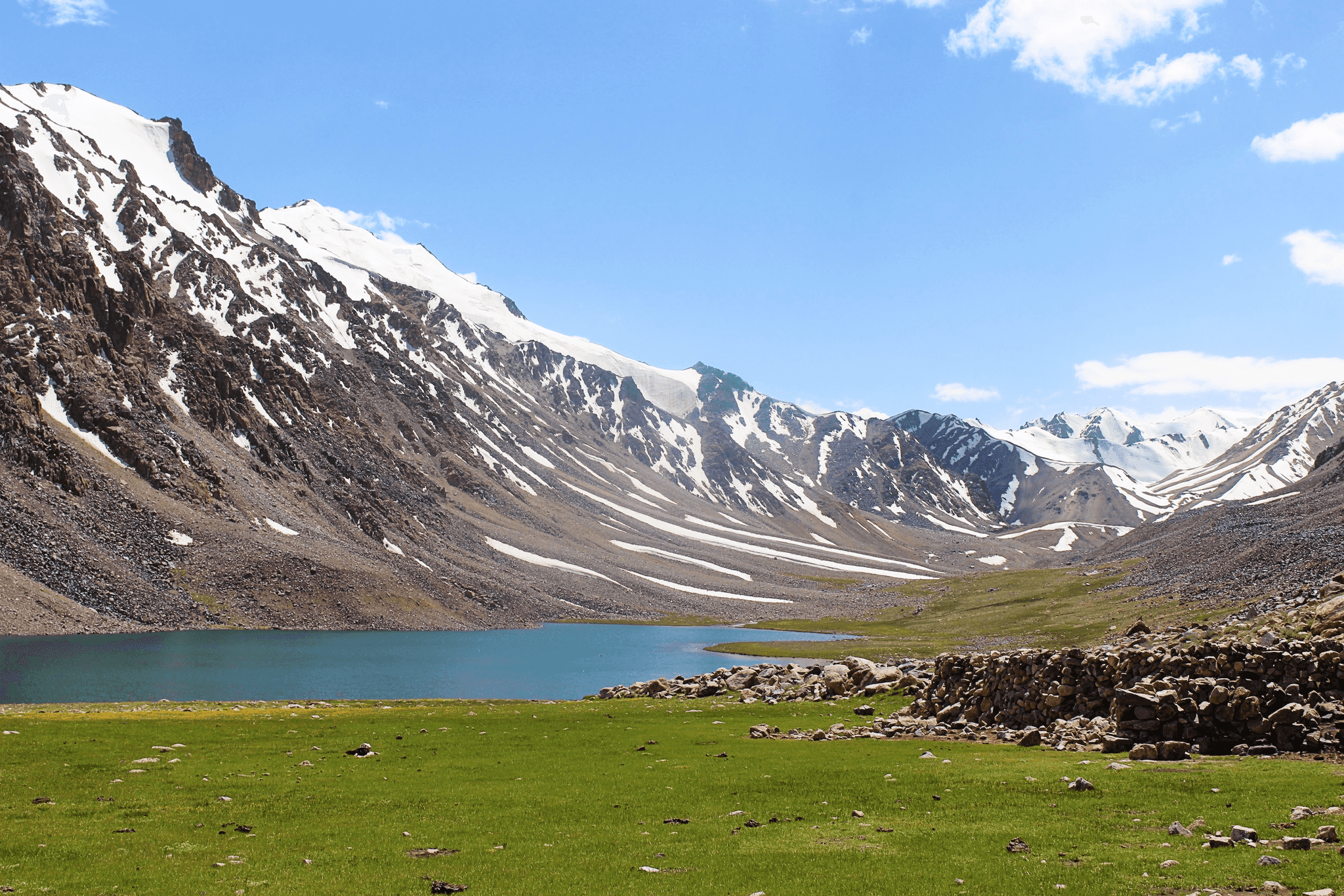
Trekking
With a couple of full trekking days behind you, the rhythm of life on the trail is settling in now. Zip open the tent, grab coffee and breakfast and spend another few hours hiking in one of the world's most majestic mountain ranges. You have just under 14km to get through today, to reach the beautiful Lake Kulen at 4445m for tonight's camp out.
Day 10
Zaroshkul and Tshakhin Lakes
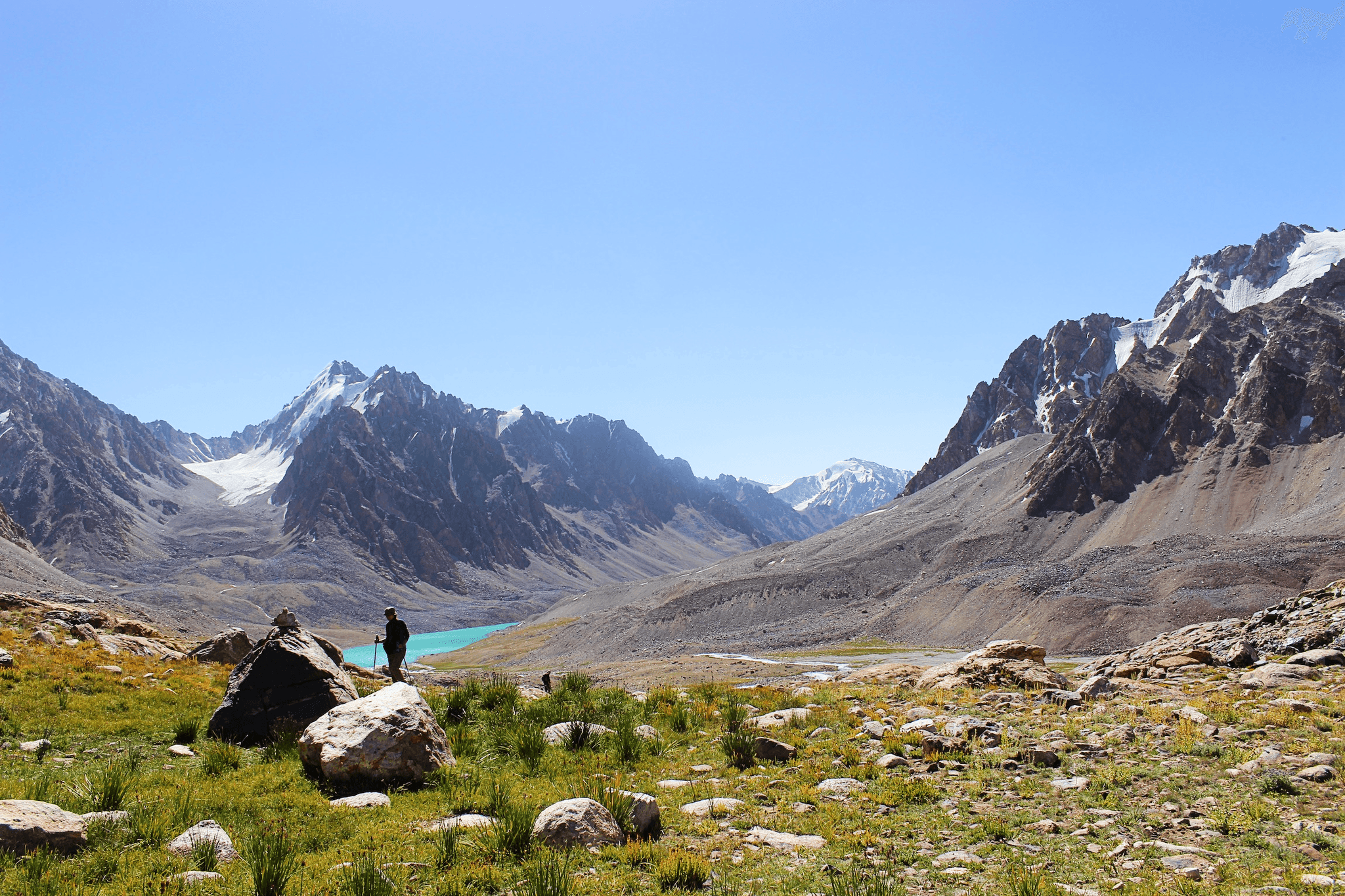
Trekking
The trek reaches two more stunning high-altitude lakes today, starting with Zaroshkul Lake at 4520m as you set foot on a section of the newly created Pamir Trail – a 1000km route across the Fann and Pamir mountains of Tajikistan. This section of the trail meanders through a spectacular valley where you'll likely see yaks en route. Tuck into a lakeside picnic lunch before continuing the hike, with several river crossings to be made on foot or by horseback, until an easy descent to Tshakhin Lake (4340m) where you'll set up camp.
Day 11
A big descent to reach the hot springs
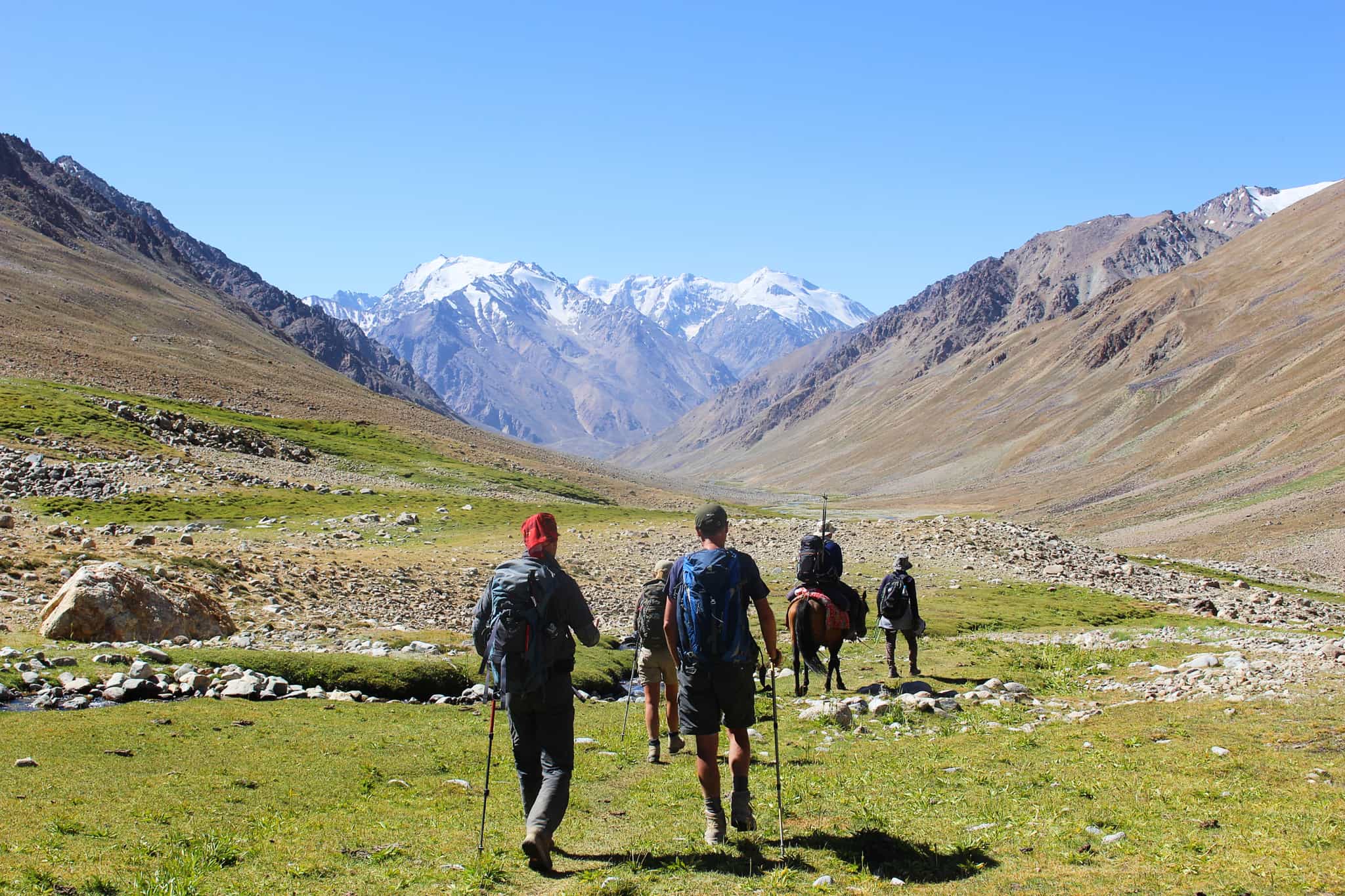
Hiking
Rise early today, fuelling up with a big breakfast ready for a tough day on the legs. Today's distance is shorter, but the descent can be hard going on this part of the Pamir Trail as your altitude drops 750m until you reach Kavk (3765m). The reward for your efforts is a big one - a short walk from your riverside camp spot are the Kavk natural hot springs, where you can soak away any aches after multiple days of trekking.
Day 12
The final push
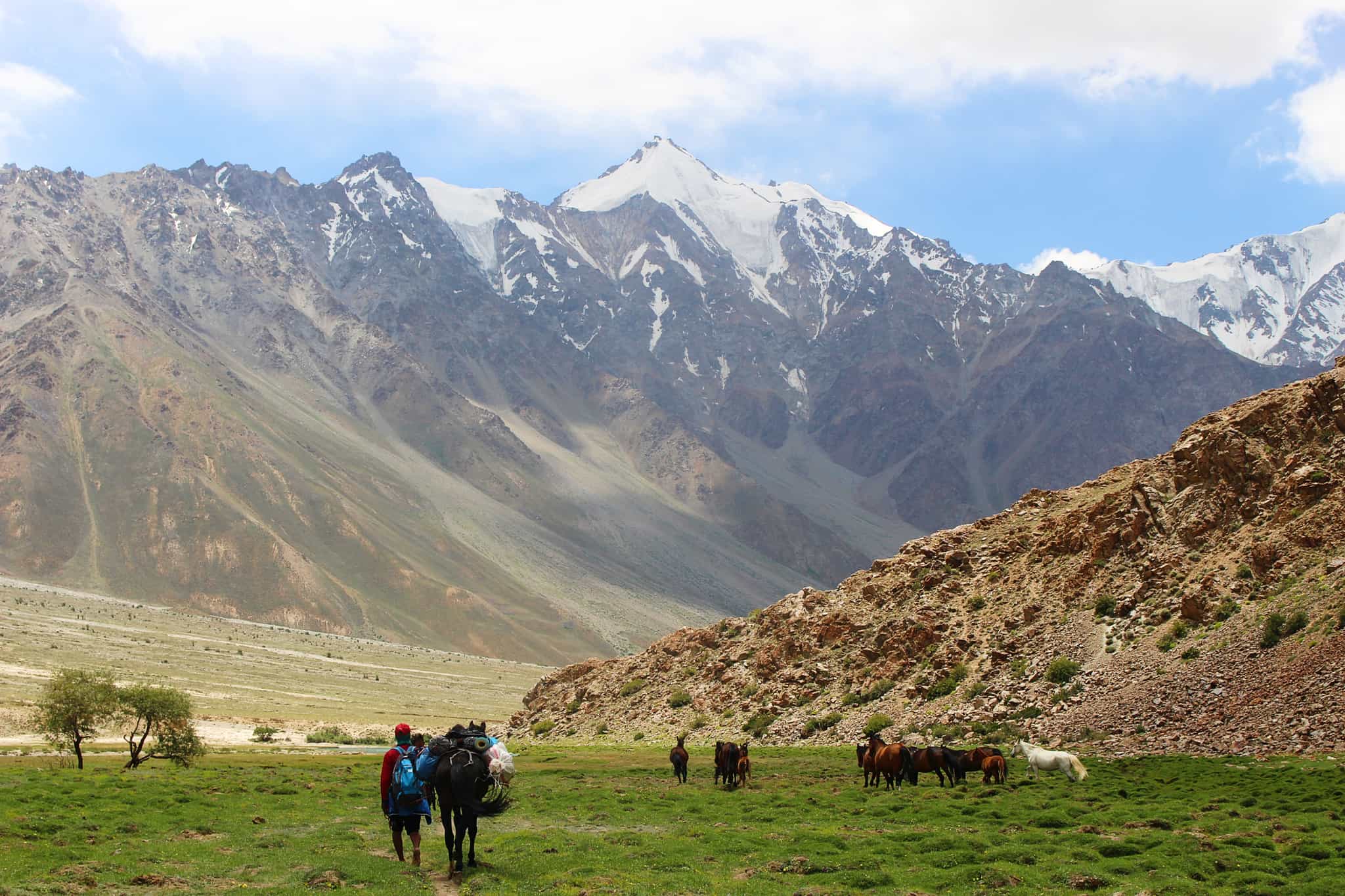
Trekking
Enjoy your last epic day of trekking today, packing down the riverside camp and setting off along the trail. The finish line is in sight as you descend to the village of Batchor (3400m) on the upper reaches of the River Ghund. This small Pamiri village makes for a perfect place to toast your trekking exploits as you are welcomed into a homestay with a local family. Spend a leisurely evening enjoying the excellent hospitality of the Pamiris, and bid farewell to your expedition team who are returning to their families today.
Day 13
Begin the journey back to civilisation
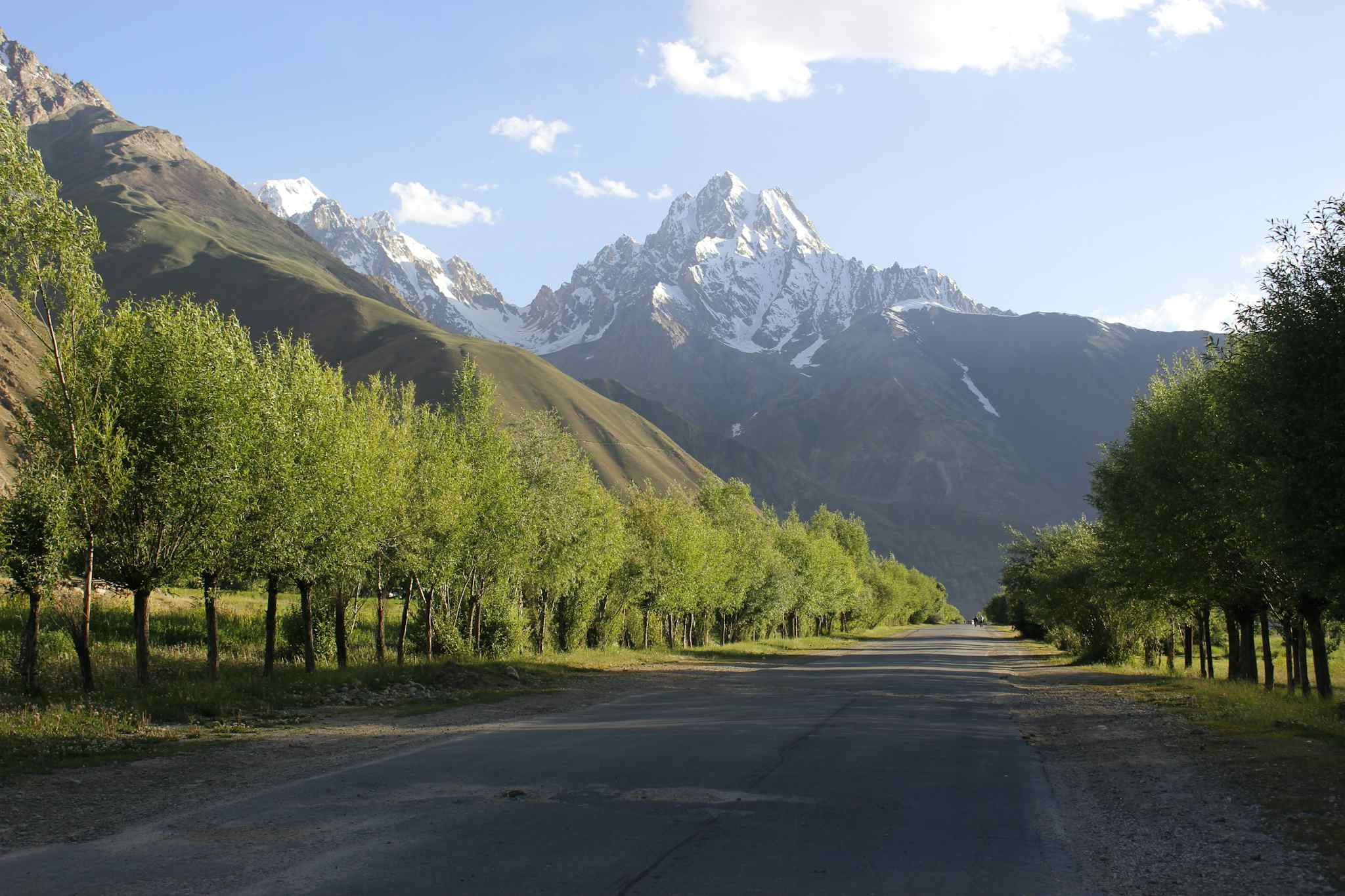
Driving
Bidding the incredible Pamir Mountains farewell, you'll hit the road again for the journey back towards Dushanbe, setting off through a deeply cut valley of the roaring River Ghund. The alpine backdrop either side of the road changes noticeably and the air gets milder and warmer as you travel along the Pamir Highway. Stop off in villages along the route for a glimpse into life in this part of Central Asia. Arriving back in Khorog, after a refreshing shower and some lunch, enjoy an afternoon stroll around the city to its beautiful park or the lively bazaar full of local craft goods.
Day 14
Khorog to Kalai Khumb
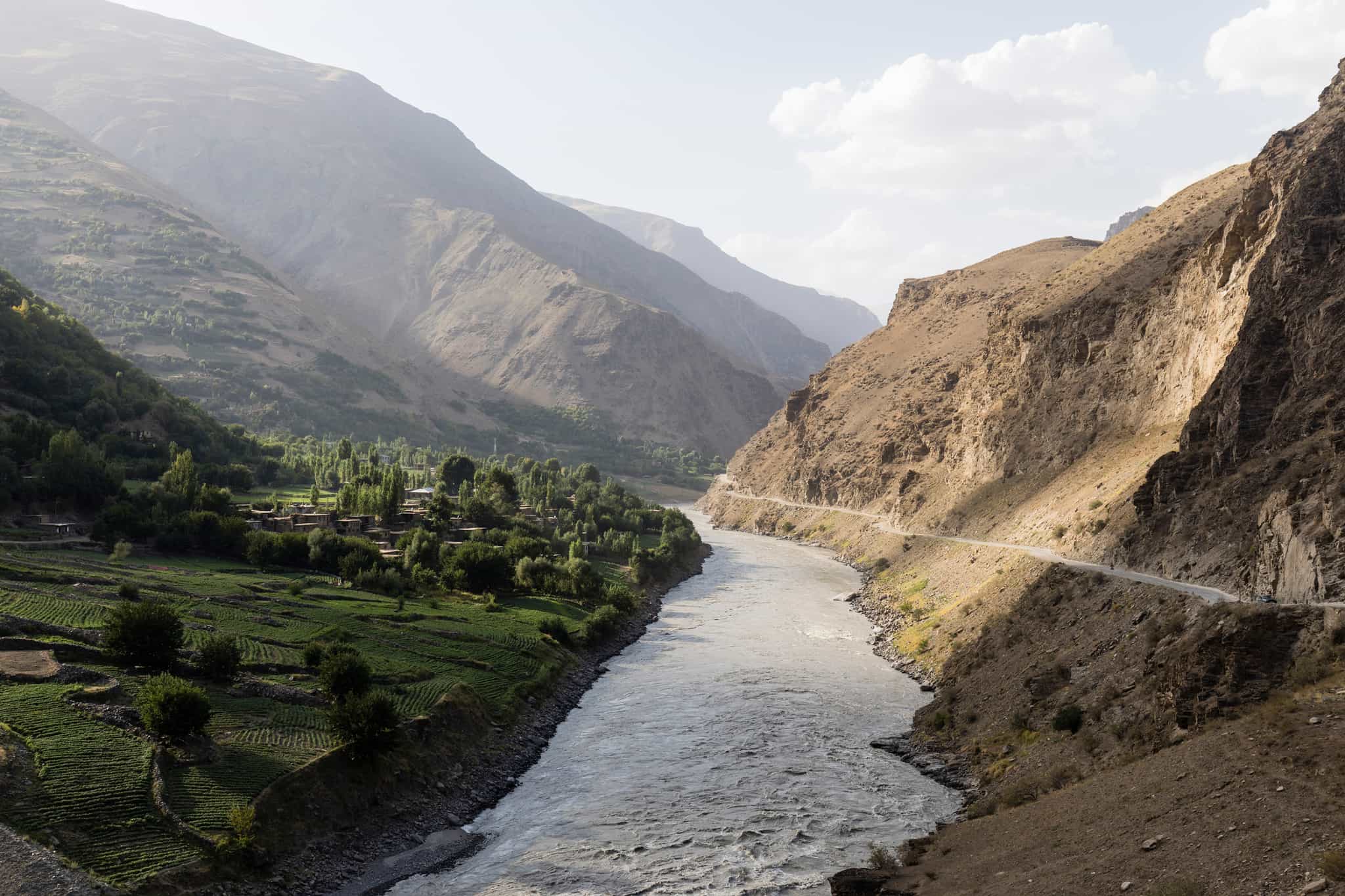
Driving
The road trip continues along the Panj River. Along the way, you'll pass through stunning terrain, with a rocky ravine deeply cut between the mountains and surreal-looking white sand dunes by the river. Looking over to the Afghan side, you'll spot 'ovrings' - perilous-looking paths cut into the steep rock walls, which are the only connections between villages. If you are lucky, you'll see locals walking light-footed with remarkable speed on these stunning constructions. In the evening you'll reach the already familiar guesthouse in Kalai Khumb, where you stayed earlier in the trip.
Day 15
Back to Dushanbe
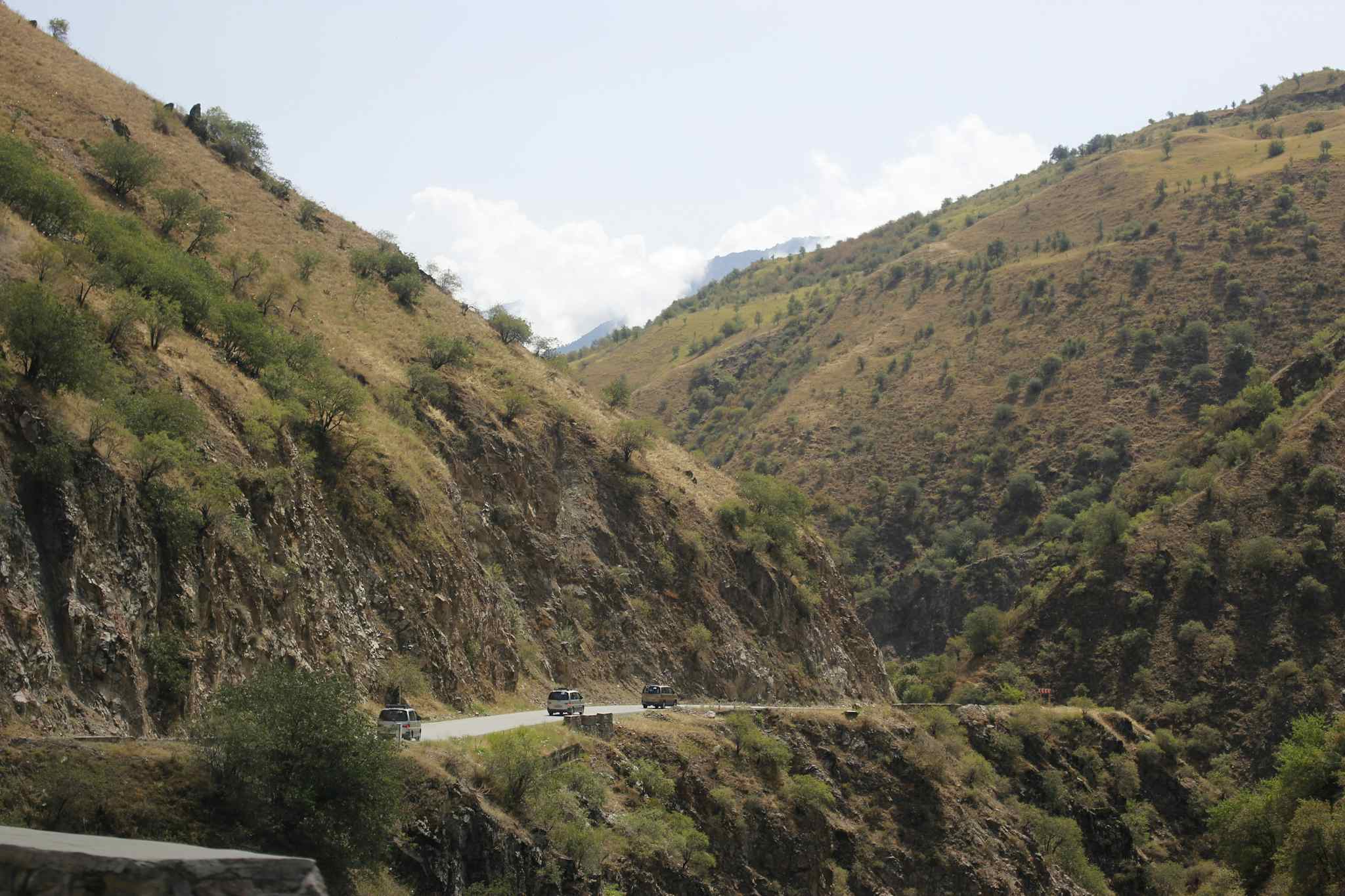
Driving
Return to Dushanbe today via the northern route via the Saghir-dasht Pass (3252m). During a short break in Tavildara,s marvel at the Navruz mountain, whose colourful rock strata are folded into a unique tulip shape. Continuing the drive, pass by numerous orchards and villages embedded in green landscape lining the way through the wide valleys of Obikhingou and Vakhsh. Check into your hotel in the late afternoon and enjoy the comforts of civilisation again. Head out for a celebratory dinner to toast your success, having completed an expedition like no other.
Day 16
So long, Tajikistan
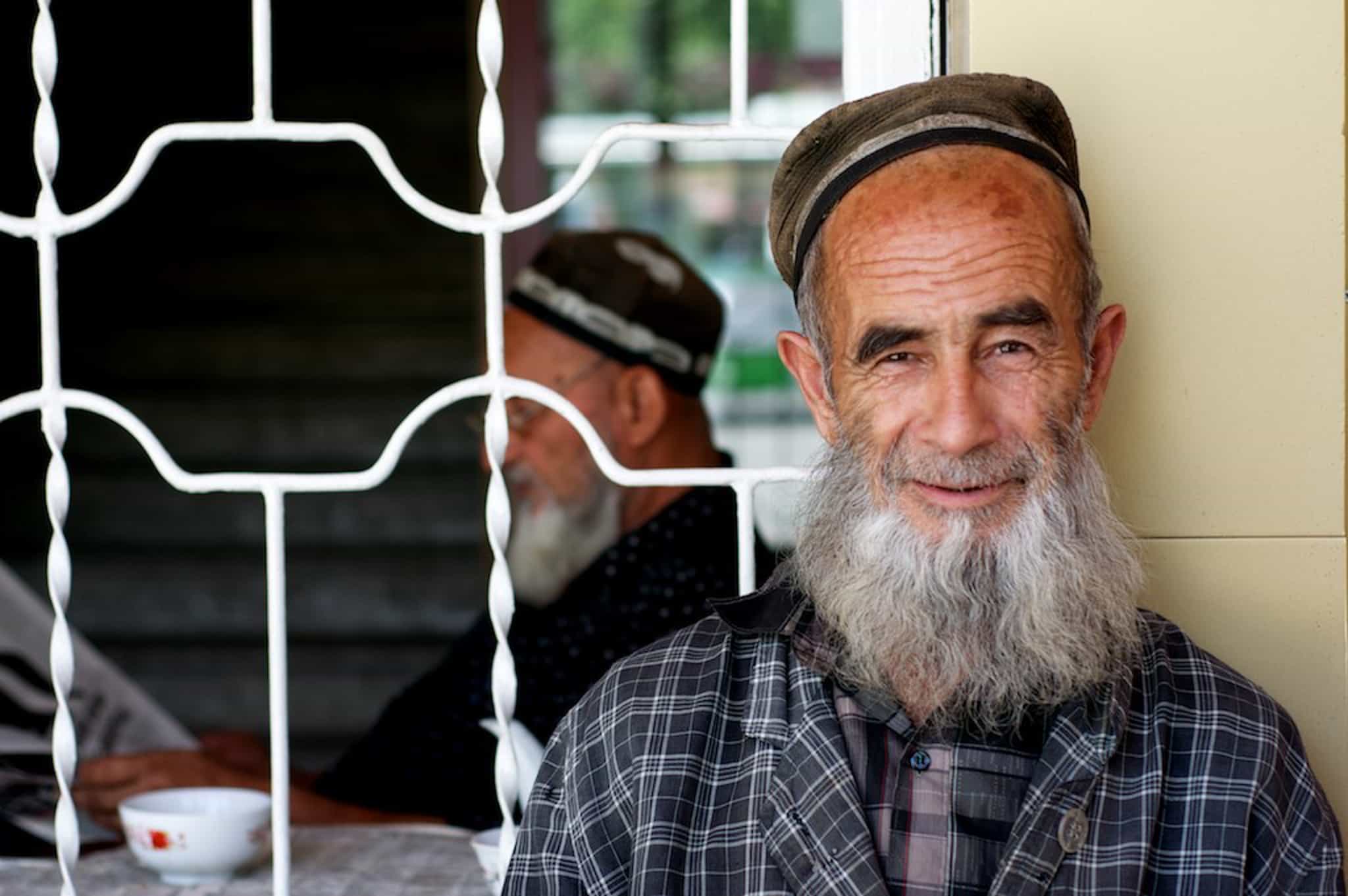
Bid Tajikistan and its people farewell today, as your epic adventure comes to an end. Your host will provide a group airport transfer in time for the early hours Turkish Airlines TK255 flight to Istanbul on Day 16. Please see the Getting There section for more details. Those choosing to stay longer in Dushanbe may wish to ask the host to assist with additional nights of accommodation and private transfers.
The Area
Logistics
Starts
Dushanbe International Airport
Early Morning of Day 2
Ends
Dushanbe International Airport
Early Morning of Day 16
Transfers
An arrival group airport transfer is included based on people taking the Turkish Airlines TK254 flight departing from Istanbul at 18:35 on Day 1, which arrives in Dushanbe in the early hours of Day 2 at 01:10am. Whilst this isn't a daily service, the trip schedule has been designed to match up with the Turkish Airlines flight schedule, as it is the main carrier into Dushanbe and offers the most international flight connection options via Istanbul depending on your point of origin.
There is also a departure group transfer included based on people taking the Turkish Airlines flight TK255 flight from Dushanbe at 03:10am on Day 16, arriving into Istanbul at 06:25am, from which there will be a range of onward flight options to connect to depending on your final destination.
Hotel accommodation is provided on first evening based on the majority of travellers arriving the early hours of Day 2 on the flight from Istanbul. For those choosing to take different flights, or if you decide to arrive several days early or extend your stay, private airport transfers can be arranged by your host at an additional cost. You can make a request with your host for additional information on transfers from within your booking.
Travel options
There are regular flights to Tajikistan from major airports across the UK and Europe, usually with a stopover in Istanbul. The most frequent airline flying into Dushanbe is Turkish Airlines from Istanbul, with flights typically arriving and departing in the early morning hours.
Day 1
Breakfast
Lunch
Dinner
Day 2
Breakfast
Lunch
Dinner
Day 3
Breakfast
Lunch
Dinner
Day 4
Breakfast
Lunch
Dinner
Day 5
Breakfast
Lunch
Dinner
Day 6 – Day 11
Breakfast
Lunch
Dinner
Day 12
Breakfast
Lunch
Dinner
Day 13
Breakfast
Lunch
Dinner
Day 14
Breakfast
Lunch
Dinner
Day 15
Breakfast
Lunch
Dinner
Day 16
Breakfast
Lunch
Dinner
What is the food like?
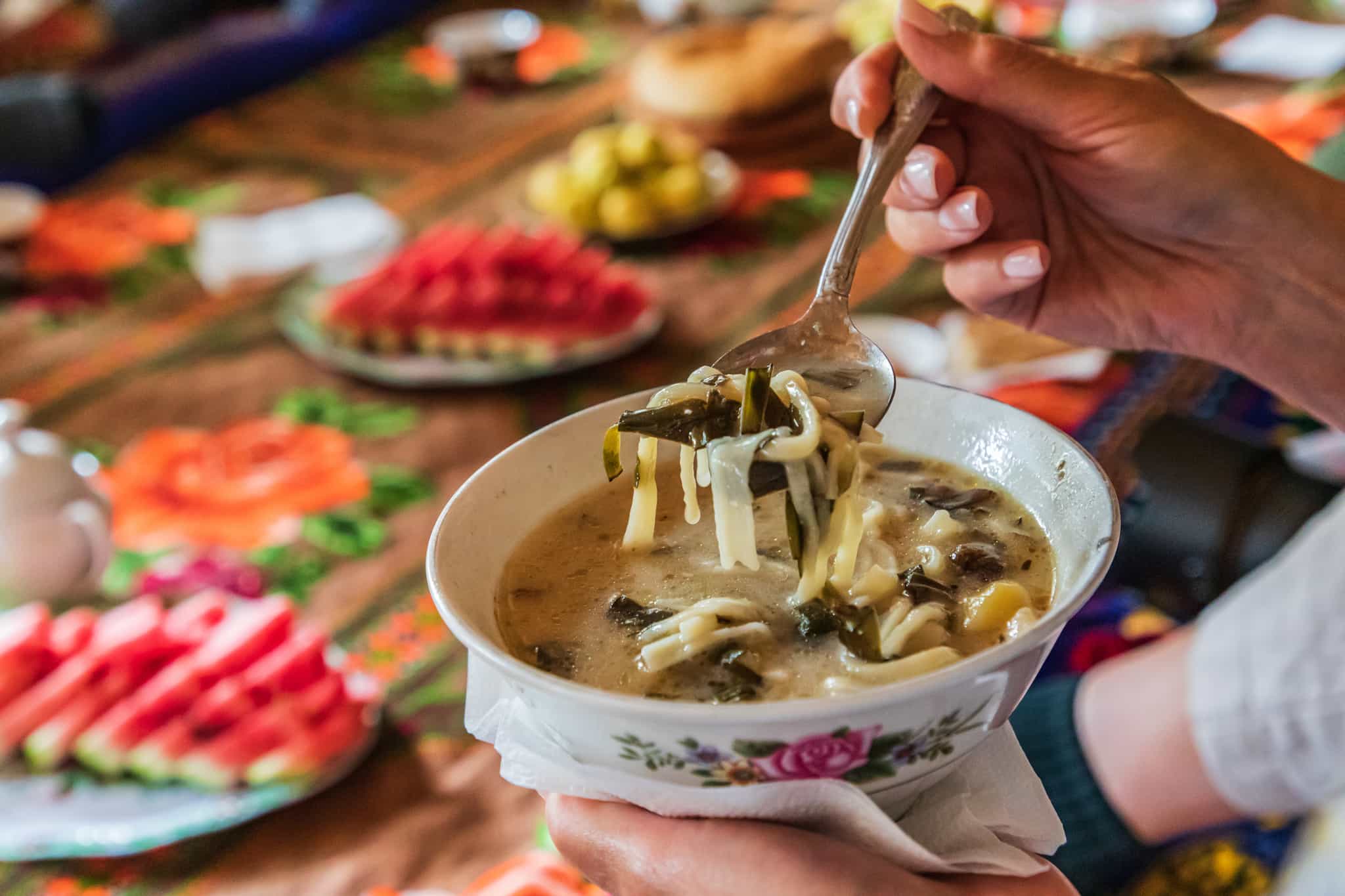
When travelling in Tajikistan, be ready for the meat-heavy cuisine of Central Asia, influenced over the centuries by Persian, Afghan, and Russian foods. Beef and lamb are commonly used and in the Pamirs, and you might try yak meat at the homestays. Different types of beans, grains and vegetables are also used, along with a dairy products, all served with non – a flatbread which is a staple of Tajik food. The king of all meals in Tajikistan is plov (also known as osh) - meat with rice, shredded carrots, chickpeas, garlic and sometimes raisins. In Dushanbe, there are many cafes and restaurants serving local and European meals with diverse menus.
The meals on your journey to and from the Pamirs will be plov, qurutob (a good vegetarian option of cheese balls served with vegetables on flatbread), manti (steamed meat or pumpkin dumplings), different soups, sambusa (puff pastry with meat), laghman (noodle soup with meat), rice, french fries, shish kabab, fresh salads, fruits, and mouthwatering fresh melon.
During the trekking expedition, breakfasts will consist of scrambled eggs, whole grain cereals, cheese, sausages, jam, honey, coffee, tea, cookies and bread. Picnic lunches will include fruit for the first 3-4 days, energy bars, chocolate bars, a sandwich or a salad, canned tuna with rice or potatoes, cookies, and dry fruits. Dinners will be two courses of hearty mountain food, such as the dishes mentioned above, along with various types of salads, herbal tea, dried fruits and cookies.
Vegetarians and other dietary requirements and allergies can be catered for - please just request this on your passenger info form. Please note due to the nature of the food available in Tajikistan, it is not possible to cater to strict vegan diets.
What is the accommodation like?
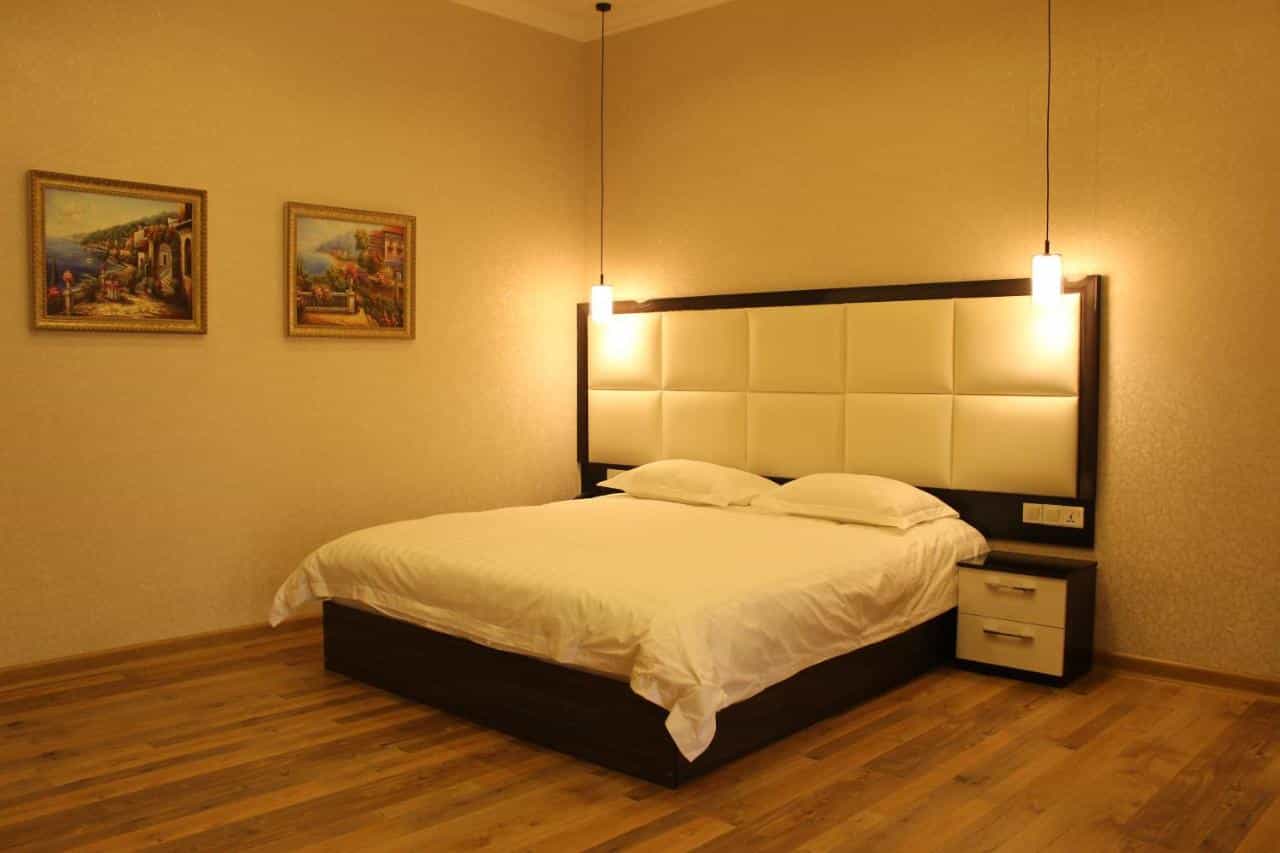
Dushanbe
In Tajikistan's capital, you will stay at the Atlas B&B Hotel in the heart of the city. The hotel has traditional decor with large courtyards, lounges and a restaurant for you to relax in after long journeys at either end of your adventure. You'll stay in twin-share rooms with en-suite bathrooms.
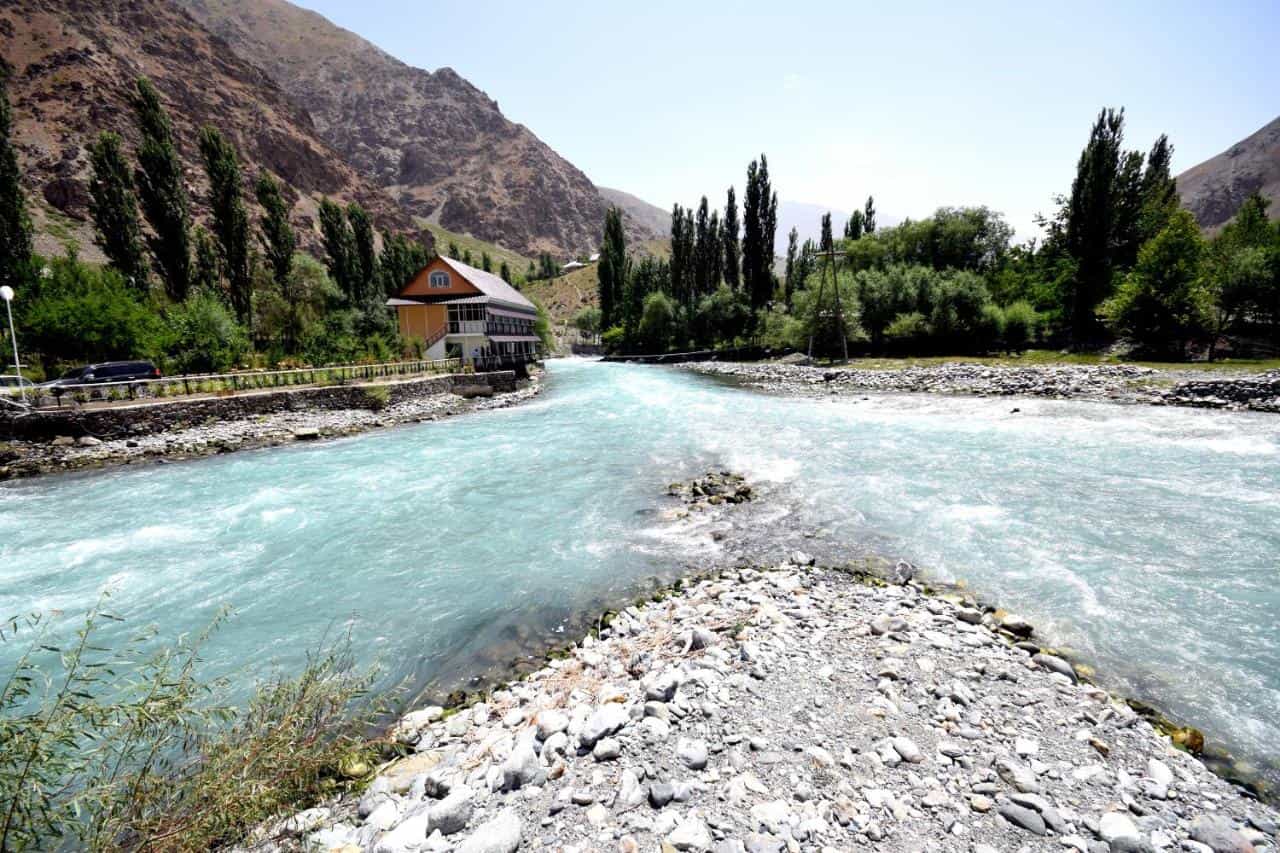
Kalai Khumb
In Kalai Khumb you'll stay at Zing Guesthouse, a classic Tajik guesthouse on the banks of the river Obikhumbou. You'll stay in simple twin-share rooms with a shared bathroom.
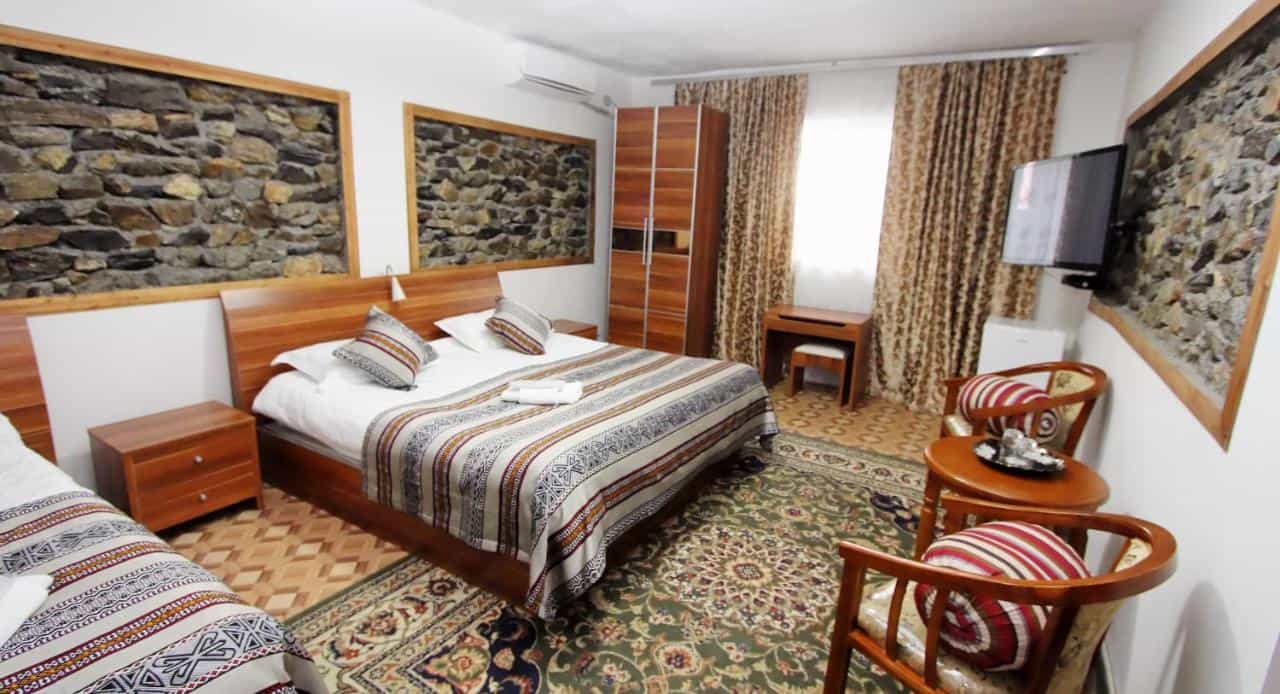
Khorog
In Khorog you'll stay at the Lal Inn Hotel - a picturesque and cosy retreat - before you head into the Pamir Mountains for a week of camping. The hotel has a restaurant, bar, a shared lounge and a quaint garden. You'll stay in twin-share rooms with ensuite bathrooms.
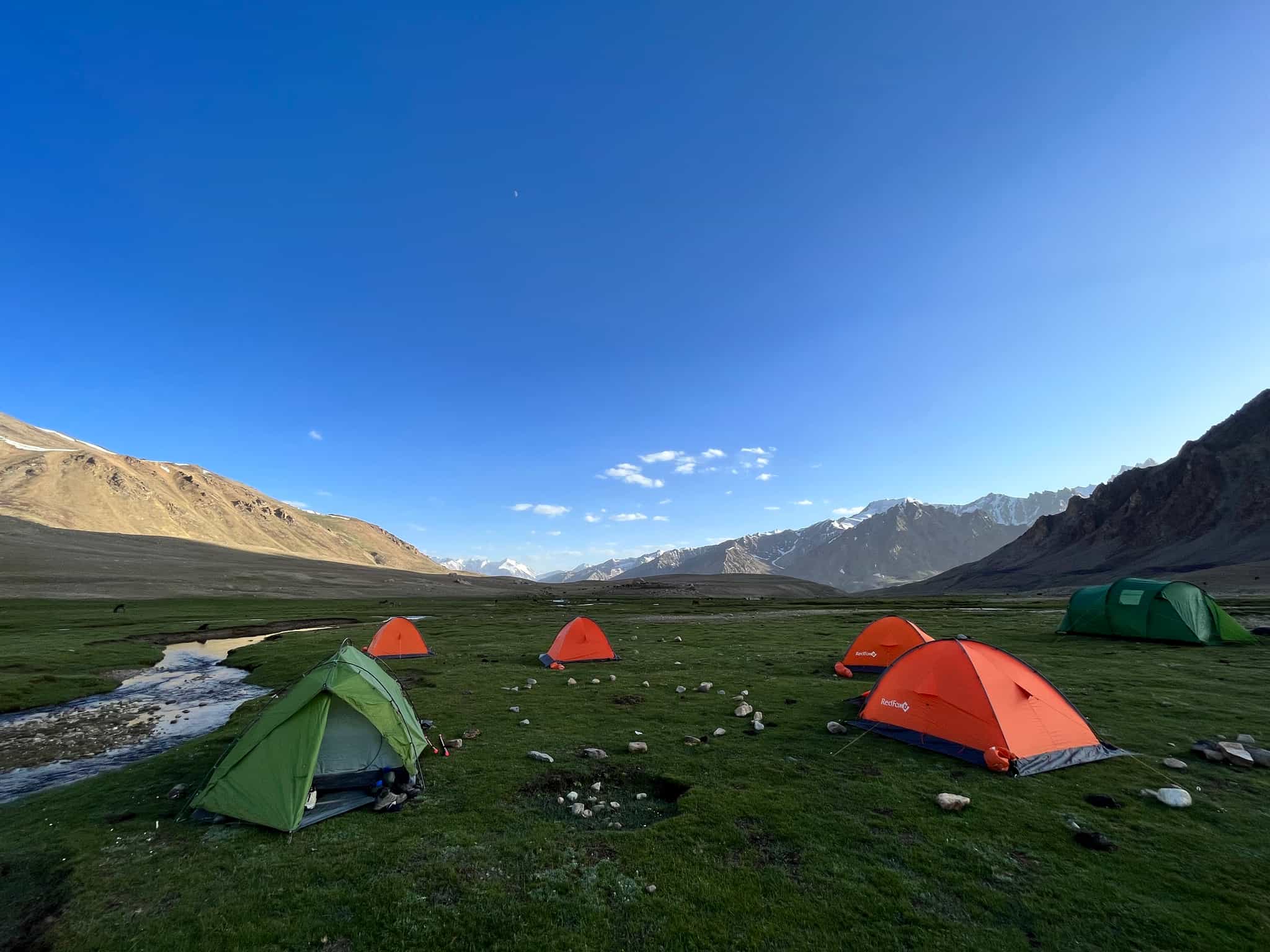
Camping in the Pamirs
Camping in the heart of the Pamir Mountains is a once-in-a-lifetime experience. The expedition setup includes a kitchen tent, dining tent and toilet tent. You'll be sleeping in twin-share expedition tents (unless you request a private tent and room upgrade – see Optional Extras for details). Sleeping mats are provided, but if you have your own Thermarest or other lightweight sleeping mat, we recommend bringing your own.
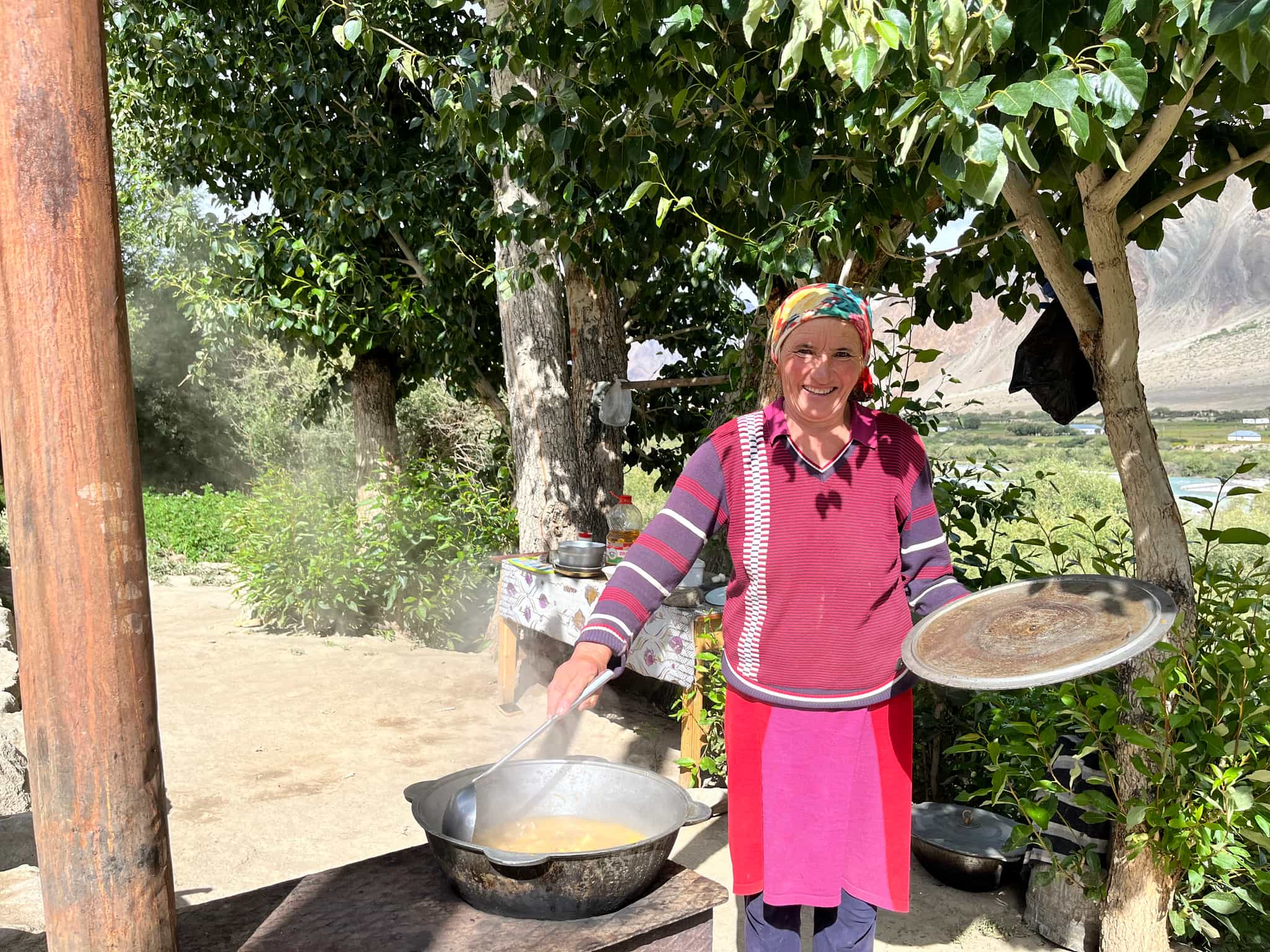
Homestay
On Day 5 in Bulunkul village (3760m) before you start your trek, and on Day 12 after your final day of trekking, in the village of Batchor (3400m), you'll experience traditional Pamiri hospitality in a homestay.
Upgrades
For solo travellers looking for their own space, an optional private room and tent can be booked for an extra charge - see Optional Extras for the price. Please request this at the time of booking (this is subject to availability). Please note, this does not cover the nights in Kalai Khumb nor the homestays in Bulunkul and Batchor.
This trip has been rated as Challenging
A good level of fitness and some previous trekking experience is required for this trip - although no technical mountaineering experience is needed. You should feel comfortable walking for up to 6 hours and 18km a day. There are some challenging passes involved, reaching altitudes as high as 4630m. The trek has been designed to avoid any bruising 9-10 hour days - you are in a seldom-visited part of the world, so the remoteness off the area adds to the challenge and adventure of this trip on top of any distance and elevation involved. There are plenty of rest stops, scenic lunches and time at camp in the evening to soak up being in the heart of the Pamirs. You will also have donkeys carrying your overnight kit, so you will only need to trek with a smaller rucksack of essentials.
What will I need to carry?
You'll need to have a larger bag suitable for all your belongings which will be transported for you by the support animals, and then a smaller trekking pack to carry personal items during each day of trekking.
The climate in Tajikistan is generally very dry, with hot summers and cold winters, fluctuating depending on the elevation of each region. Tajikistan has around 280 days a year of clear skies, so chances are decent that you'll be trekking in fine conditions. The climate in the Pamirs is drier than the ret of Tajikistan. The best time to visit is the end of May to end of October, and for the trekking the ideal months are between June and September. The average daytime temperatures in May-September range from 20°C/68°F to 25°C/77°F, and at night temperatures can drop to 0°C/32°F. Please note that in the Pamirs, after a long sunny day, you can have a light snowfall at higher elevations, and night time temperatures in July-August can range from 15°C/59°F to 5°C/59°F. In Dushanbe and on the lower elevations parts of the trip as you journey to and from the Pamirs, the temperature can range between 25°C/77°F and 40°C/104°F.
Wonderful unspoilt pristine mountains almost devoid of other trekkers. Go before everyone finds them and the place is over-run. The scenery was truly spectacular . An added bonus were the prolific alpine flowers and their scent
Untouched, rugged and beautiful!
I feel very lucky to have been able to visit this part of the world and see some of the sheer untouched beauty!! It's not often now you can find somewhere so isolated, and be able to access it yourself in such a way. I hope Tajikistan welcomes more tourists soon as it does have a lot to offer.
The days of driving are tough with road conditions leaving a lot to be desired, but this is all part and parcel of visiting central asia in my opinion and makes it part of the adventure!!
Remember you're going to one of the least visited areas of the world which is generally quite new to tourisms, so be prepared to be quite rough and ready. And of course it can be a challenge with unpredictable weather, things not always going 100% to plan, and the higher altitudes of course, but for me this is exactly what I expected, and always makes it into more of an adventure and memorable experience for me!
Muhammed made sure everything ran smoothly to the best of his ability and did a lot for us. We wouldnt have got to where we needed to be in one piece without him and the team, so thank you :)
Bare in mind that the hot springs are about a 2 hour walk from the final camp.
In this day and age, genuine adventures off the beaten track are hard to come by but Tajikistan offers precisely that - with stunning mountain views, incredibly turquoise glacier-fed lakes and amazing hospitality to round things off.
Guides
English-speaking tour leader, specialist local mountain guide and an expedition chef
Accommodation
7 nights in guesthouses and hotels, 6 nights camping, 2 nights in a Tajik homestay
Meals
All breakfasts, 12 lunches, 10 dinners
Transfers
Airport transfers and everything in between
Porterage
Donkeys and porters will transport your luggage during the trek, plus a support horse will be available
Equipment
Expedition tents and sleeping mats
Permits
Tajik National Park entry permit, GBAO permit for travel in the Pamir region
Our trips are hassle-free by design. We include all the activities and equipment, as well as many of the meals, so you can simply rock up with your rucksack and share the adventure with your new pals.
Personal Expenses
You know your own spending habits best, so please budget an appropriate amount for things like optional meals and drinks, shopping, optional activities, and laundry.
What do I need to bring?
Bags
- Soft overnight duffel bag or rucksack (this will be carried by donkeys on the trek)
- Trekking daypack (25+ litres)
- Waterproof liner for daypack and rucksack
Please note, there is a 15kg limit for the luggage carried by the porters and donkeys. You can bring more to carry with you on the trek if you wish.
Clothes
- Down jacket
- Waterproof jacket
- Waterproof trousers
- Breathable wicking layers
- Fleece jacket or similar
- Thermals (merino is best)
- Warm hat
- Gloves
- Buff or neck scarf
- Lightweight trousers/shorts/skirts/t-shirts
- Underwear and socks
- Swimwear
- Sunglasses
- Sunhat
- Something to sleep in
- Waterproof hiking boots (worn-in)
- Sandals or trainers for around camp
Sleeping
- Cotton or silk sleeping bag liner
- Sleeping bag (4-season, rated down to -10°C)
- Travel pillow or pillowcase
- Thermarest or sleeping mat (optional - foam ones are provided, but pack yours if you have a preference)
Other
- Trekking poles (optional but recommended)
- Universal travel plug adapter
- Power bank or solar charger
- Passports (and visas)
- Travel insurance documents
- Ear plugs
- Suncream
- Personal first-aid kit (inc. blister treatment)
- Personal items (biodegradable toiletries, sanitary wear etc)
- Toilet kit (toilet paper, biodegradable bags)
- Quick-dry towel
- Alcohol hand-gel
- Headtorch or torch
- Reusable water bottle x1 litre and/or hydration bladder/pouch
- Quickdry towel
- Biodegradable wet-wipes
- Energy bars and snacks (optional, local snacks provided)
- Water purification tablets or treatment system
Note on Camera Equipment: Drones, even small ones used for personal videography, are prohibited in Tajikistan, so leave this flying tech at home
No optional extras are available for this trip.
We partner with the World Land Trust to ensure this trip achieves Net-Zero emissions. We also support their Buy an Acre programme, helping local communities to buy and protect natural habitats in perpetuity.
What's the number?
It works out on average at 384kg of CO2 emissions per person, including all local transport, accommodation, food, activities, guides, staff and office operations.
The only thing it doesn’t include right now is flights and travel to the destination. We do make an overall estimate across all our customers separately, but as we don’t book flights, have customers from all corners of the world, and no way of reliably knowing their travel plans, we simply can’t include an individual number in the figure on display here. We’ve got a goal to fix that, so that when you book, there is a way to measure and mitigate the carbon emitted by your flight too.
But what does the number mean?
Yep, hard to picture eh? To give you an idea:
- Driving 1000 miles/1609km would be approximately 281kg of CO2 in an average car (or 140.5kg per person, if there were two of you in it).
- A return economy class flight between London and New York would be approximately 1619kg (1.66 tonnes) per person.
- 10 trees in a temperate forest are estimated to remove approximately 250kg of CO2 from the air in a period of 5-10 years.
What are we doing about it?
Our trips are relatively low-carbon by design, and we're working with all our hosts to develop long term carbon reduction plans. We partner with the World Land Trust to ensure this trip achieves Net-Zero emissions. We also support their Buy an Acre programme, helping local communities to buy and protect natural habitats in perpetuity, ensuring the protection of the reserve and its wildlife.
Want to know more?
Amazingly, no international travel company has ever publicly published their carbon measurements before, as far as we know. We believe that must change, quickly. So we’re openly sharing the method we used in the hope that other companies will be able to more easily follow suit and build on what we've done so far. You'll find it all here.
Tips are not included in the trip cost. These are entirely at your discretion but there is an expectation to tip for good service. Your guide will help with advice, however we suggest the below as a guideline per person:
$5 USD per day
Of course, you are free to tip more or less, and the amount should be reflective of your perception of service and quality - a tip is not compulsory and should only be given when you receive excellent service.
Your expedition guides will be providing boiled and treated water throughout the trek. If you would like to bring your own water filter to safely fill up from the rivers and streams deep in the mountains then please refer to our guide on the best water filters for adventurers.
This depends on your nationality and some travellers will need a visa, for example UK travellers will need a visa arranged in advance and can find further information on the FCDO Travel Advice pages. You should contact the Tajikistan embassy in advance for options, including E-visa services which tend to be the easiest option.
For those countries that have a visa-free agreement with Tajikistan, there is still however a $30USD fee applicable pre-arrival to be registered with the local authorities, which you host will assist with.
For all travellers your host will assist with obtaining the GBAO permits for you to travel through the Pamir region of Gorno-Badakhshan. For this your host will need a copy of you passport ID page (either scanned or photo). Once you've made your booking please email your passport copy to [email protected] with your date of travel and booking reference.
Homestays in Tajikistan are very basic, especially in the Pamirs. Your host has chosen the best possible homestay with friendly hosts, good traditional food, a shower, a European toilet, and enough space for the group. You'll share a room with between 2-4 people depending on the group size, and you'll sleep on traditional mats filled with cotton. Pamiri houses are called chid and are steeped in philosophical and religious relevance. The main room is divided into a few sections: a cooking and sleeping area, a place to study or keep clothes and it has only one window called a ravzana. The ceiling symbolises four elements of the universe: fire, earth, air, and water. The homestay in Batchor is run by a lovely lady called Gulsimo and has a nice view of the valley. Meals are taken sitting cross-legged on the floor. Electricity and hot water are in short supply, so guests will be asked to be mindful of the length of showers. Anytime you are invited as a guest to a local home, it’s expected that you take off your shoes before entering the house. Also during mealtimes which are taken sitting down on the floor, do not step on the tablecloth during the meal, as it might show disrespect to the local host. Expect to be told to have more food and tea, but feel free to gently decline.
Owing to the nature of this trip, it is essential that your personal travel insurance policy provides cover to the maximum altitude visited on this trip (4630m).
Sure can! Over 70% of our travellers travel solo, it’s a great way to meet like-minded people.
Our team of Adventure Hunters co-create exclusive adventures which are run by highly vetted, specialist hosts. The trip is run by our trusted host partner in the destination. We only work with independent, local, in-destination experts who know the very best places to explore and how to stay safe. Read more information about the local teams we partner with. You’ll be introduced to the host straight after making a booking via the Much Better Adventures platform.
Much Better Adventures refer to the UK Government’s official travel advice when designing trips and monitoring trip operations. We recommend that all customers are familiar with the practical information provided on the Government’s FCDO website, where current travel advice can be found by searching for the applicable destination(s).
For customers joining this trip from other international destinations – please also read the official travel advice applicable to your country of residence/origin, as this may differ.
We recommend checking out the country-specific information and also talking to a travel nurse.
We automatically convert prices from the local currency that a host receives to your chosen currency. We update our exchange rates on a daily basis so this does mean that prices displayed on the site are subject to currency fluctuations, which is why you may see them change over time.
If you wish to change the currency you pay in, head to the bottom of the page.
All of our group adventures are specially designed for adults to enjoy as we want these adventures to bring together outdoorsy people who are truly like-minded. You must be over 18 to join one of our trips.
You're always in good company on one of our adventures.
Our trips are typically made up of a mixture of solo travellers and small groups of 2 or 3 friends, with most in their 30s-50s.
Our sociable adventures are solo-friendly by design and naturally attract outdoorsy people with a shared mindset; a love for adventure, a desire to push themselves and meet awesome, like-minded people along the way.
It’s this camaraderie that has so often turned a great adventure into a life-changing one.
Don't just take our word for it:
- 95% of people rate the group dynamics on our trips 5/5
- 90% of people recommend joining a trip to make new friends
- 75% of people have met people on our trips that they would now consider friends
See here for more info about the Much Better Adventures tribe.
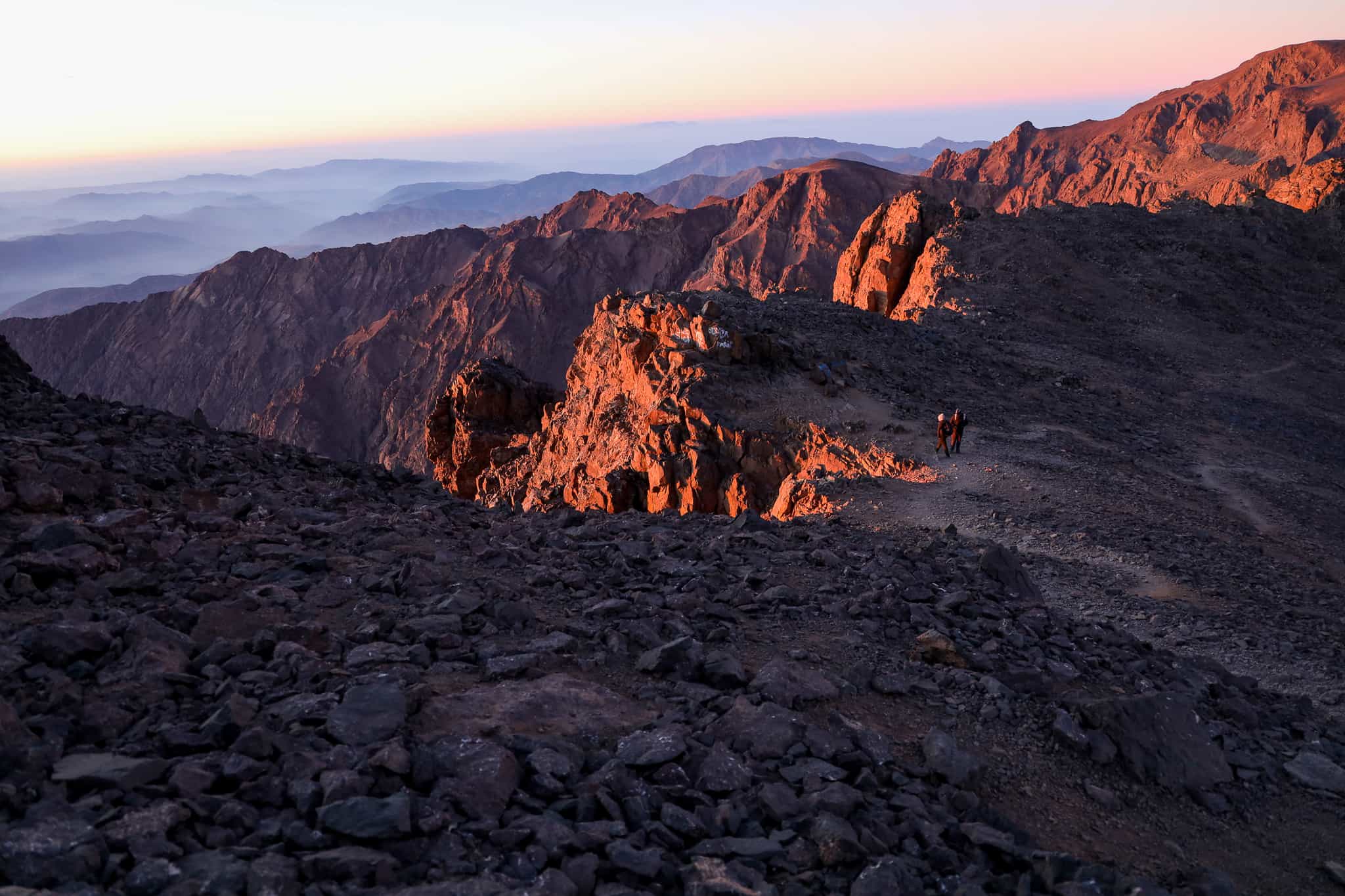
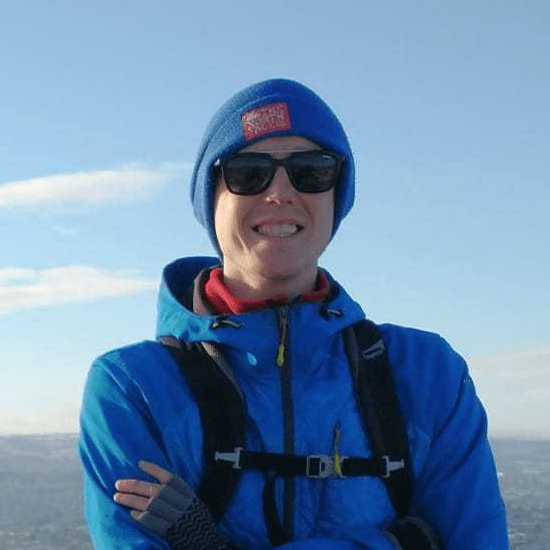
Need help finding flights?
From logistics and how to get there, to fitness, group dynamic and trip difficulty, Rory and his team of friendly experts are on hand to help.
We've got your back
Guaranteed to run
All Much Better Adventures trips are now guaranteed to run. Once you’ve booked your spot you can immediately make your travel arrangements, no uncertainty, no hanging about (excludes 'request to book' departures). Full details
Flexible payments
Secure your spot with the minimum deposit and pay off the remaining balance in as many instalments as you like, with no interest or fees. Full details
Happiness Guarantee
We’re so confident you’ll have an amazing time we’ll put our money on it. Full details
Full financial protection
To give you complete peace of mind Much Better Adventures is backed by ABTOT, ABTA and ATOL memberships. Full details
Tried & Trusted
Much Better Adventures is rated ‘Excellent’ on Trustpilot with over 1000 verified trip reviews averaging 4.8/5.
Connect before you go
You'll be invited to join a WhatsApp group to get to know each other before your big adventure together. Full details
DEPARTURE DATES





